Video
youtube
The Ballad of Roy and Silo
(When Gay Penguins Go Straight)
Urban Barnyard
Capping off the Queer Issue today with a Ballad for some of my favorite Queer Icons, Roy and Silo. From the album, Scream Like Human Beings! Urban Barnyard presents a song for the penguin couple’s (in)famous and highly politicized relationship.
Thank you all for reading - it’s been a pleasure sharing this!
-Lee Pivnik, for the Institute of Queer Ecology X ECOCORE
1 note
·
View note
Text
FUCKING PANSIES:
Queer Poetics, Plant Reproduction, Plant Poetics, Queer Reproduction
Caspar Heinemann
with images from Lee Pivnik

‘Waking, I was certain my room was host to a demon; terrified, I watched the remorseless eyes in the half light, till dawn gave me the courage to bolt shivering with fear to my parents’ bed. My father laughed: ‘Don’t be such a pansy, Derek.’ -Derek Jarman, Modern Nature
Don’t be such a pansy, Viola tricolor, violet, heart’s-ease, love-in-idleness; Pansy goes by many names, and many names fit into and fall under ‘Don’t be such a pansy, _______.’ Don’t be such a pansy, even if there’s a remorseless demon in your room, crouching in the dark, ready to tear you apart. Even if there’s a whole remorseless world out there, even in your parents’ bedroom, ready and waiting to tear you apart.
The pansy has remained a staple in anti-queer lexicon since the last century, the humble violet symbolising weakness, effeminacy, all things effete, wimpy, and generally flowery. Propagating alongside its siblings sissy, fairy, and faggot, the pansy is a resilient flower. However, its roots as an insult are not strictly horticultural. The etymology of pansy (flower) is the French pensée, the past tense of ‘to think’, and a feminine reflexive. This occurred when, in a dubious feat of anthropomorphising, the pansy was seen to resemble a person leant over in intense contemplation, which in turn led to it becoming a symbol of remembrance. As an insult, it was applied to the ineffectual intellectual, implying an emasculating failure to embody a forceful, active, masculine ideal. The quality of thoughtfulness was already both feminized and feminizing, but the first known use of the word to describe gay men was not until 1925 (Partridge, 1984).[1] At some point along the way, the studious pensée became the flamboyant pansy, the femininity of the insult taking precedence over any other qualities. With ‘pansy’ having no non-floral meaning in English, in popular usage any association with remembrance is forgotten. The intellectual intellectual basis of the insult becomes obscured through time and translation and all that we are left with is the ontological relation of a human subject to the Viola tricolor itself, and the vague sense that there is something not right in the boy who thinks too much, looks too closely.
When the insult ‘pansy’ is thrown, there exists the obvious implication that the victim is themselves, physically, a pansy. But alongside this, to be a pansy is most likely to also be someone with an affinity for pansies, someone who would rather draw flowers in the garden than kick a ball around, a boy who would rather have a bunch of arum lilies than a brace of pistols (Jarman, 1992, p28). Being a pansy is seen as both a cause and an effect of an underlying affection for the delicate, the pretty, and the decorative. Pansies love pansies because they are pansies, which is why they are pansies. The love of pansies is a red flag on the slippery slope to becoming a pansy, and the pansy is a pansy because pansy is the word for people who love pansies. This is not an intentional morphing, but rather, after all those hours in the garden someone turns and says ‘Don’t be such a pansy’, and then there is a demon in your room, and it is clear a pansy is a bad thing to be, which is strange to consider for someone who loves pansies, but lots of things are going to be strange from now on.
The homophobia of the insult pansy is not just the implication of effeminacy from association with the flower itself, but the homophobic condemnation of perceived sameness. The pansies love of pansies is taboo in part because they are a pansy, there is no heterosexual difference in pansy desire. However, the pansy-pansy identification is not the same as Narcissus falling in love with his own image, not the egocentric self-adoration of the daffodil leaning into the pond. The pansy is intensely relational and curious, and loves other pansies (and daffodils and geraniums and buttercups and snowdrops). Remember, the pansy becomes a pansy through perceived similarity and/or attachment to other pansies. The initial recognition was with something they were yet to become. In this way, pansy is inherently a collective identity, inhabiting a multiple temporality. To clarify, this is not an essentialist argument that all pansies like pansies, as in, ‘all people perceived as queer men like Viola tricolor.’ But rather, that its formulation as a generalised homophobic insult, potentially applied to any queer man, or any person read as such, means that ‘queer men like queer men’ (uncontroversial) can be read as ‘pansies like pansies’. The collision of this meaning, with the horticultural association, begins to create a framework for a positive understanding of queerness, reproduction, survival and the natural.
As with many anti-queer insults, an underlying assumption in pansy is that there is an unnaturalness to effeminacy, that it signifies something gone astray that would never thrive or even survive in the state of nature, a rupture in the normatively gendered Arcadian ideal. The pansy clearly cannot be a real man, because he is a flower, and flowers are not men, and men are not flowers. But even the most ardent homophobe would find it hard to argue that flowers are not ‘natural’, even in all their selectively bred garden centre glory. Whilst not wanting to perpetuate the myth of queer sex as inherently unreproductive, it is important to not deny that queerness still exists with a turbulent relationship to reproduction, in the biological sense. At the heart of this is the existence of queerness in relation to a medicalised discourse that understands the queer subject in terms of biology, in a way that is inherently naturalised, assuming queerness as something to be located in genes and hormones, glands and chromosomes.
This is not a form of acceptance or understanding, but rather a naturalisation that implies a failure, a departure from the script of healthy, normative heterosexuality and gender. When the queer body is accepted as a natural form, it is always a defective natural body, an abnormality that reinforces the norm. Homophobic and transphobic discourse has adopted this position in recent years, in reaction to the realisation that an understanding of the queer body as unnatural has the unintended consequence of devaluing any biologically based understanding of gender and sexuality, rendering the cisgender heterosexual body equally unnatural.[2] In reference to the earlier (and still present) form of anti-queer rhetoric Greta Gaard (1997) points out the irony that when homophobes use the argument that to be queer is to be against nature, they are insinuating that they care about ‘nature’, which is rarely the case. This is especially true for people coming from a fundamentalist Christian theological perspective in which man’s dominion over nature is central. She writes that ‘in effect, the "nature" queers are urged to comply with is none other than the dominant paradigm of heterosexuality.’ Nature becomes a weaponised synonym for reproduction, and everything that does not directly contribute to the survival of a the species becomes an affront.
As much as the queer is being called a flower, the flower is being called a queer. As much as the pansy lends its prettiness to the queer subject, the queer subject lends their effeminacy to the pansy. Although this could be read as a reductive anthropomorphising, there is also the potential for something else if the relationship is not read as one-way mapping of human characteristics onto flowers, but also flower characteristics onto humans, with implications for the agency of both. Gaard asks us to think not only in terms of the dualisms traditionally associated with conversations around gender, race, and nature, but the ‘vertical’ associations, ‘between reason and heterosexuality, for example, or between reason and whiteness as defined in opposition to emotions and nonwhite persons […] the ways queers are feminized, animalized, eroticized, and naturalized in a culture that devalues women, animals, nature, and sexuality […] how persons of color are feminized, animalized, eroticized, and naturalized. Finally, we can explore how nature is feminized, eroticized, even queered’ (1997). Taking this as a call to arms, there is the potential for a queer identification with what is termed ‘nature’ to have positive political implications not just for queerness, but for a wider ecological and social struggles.
When read against a binary understanding of human reproduction, flowers are inherently queer. This is not a modish application of the term ‘queer’ to anything remotely ‘strange’, divorced from its roots as a slur or any analysis of human sexuality and gender, but rather a comparative statement about human understanding of gendered bodies across species.[3] While the term ‘queer’ is referring to a very specifically human (and mostly white, Western) subjects navigation of a social world, it is also inaccurate to think of plants (and other species) as exempt from and untouched by this discourse. Given the prevalence of anthropocentrism, the reading of gender in plants inevitably reverberates and affects human understanding of human gender, and the reverse. As well as not wanting to make an anthropocentric imposition onto plants, I also want to avoid essentialising queerness in humans. To borrow from Nicole Seymour, I do not want to ‘claim that queer individuals necessarily have a particular kind of relationship to the non-human; [but focus] primarily on the queer relationships that humans might develop with the non-human, and how environmental ethics might emerge from queer practices and perspectives’ (2013, p29). I would add to this an investment in thinking through how queer ethics might emerge from environmental practices and perspectives. The queer anarchist collective Baedan define queer as ‘the inherent decomposition which afflicts gender […]; not this or that historically constituted subject category, but all the divergent bodily and spiritual expressions which escape their roles’ (2014). Rather than a positive, universalising usage of queer, queer is a contingency. I hope the clumsiness of attempting to talk about how plants fuck spills over, somehow, into somewhere productive (or unproductive).
The number of scientifically validated genders for plants far exceeds those commonly understood and accepted for humans. At the most basic level, single flowers are either male, female, or bisexual (also referred to as ‘perfect’, hermaphroditic or androgynous). However, categories proliferate due to the fact that different plants grow different combinations of male, female, or bisexual flowers. This does not mean that all species have male, female, and bisexual flowers - it is possible for plants to only have either bisexual or female flowers, for example. This is complicated further by the fact that in some species, the flowers will change gender. It is important to clarify here that when we are talking about plant gender, we are potentially discussing at three different scales - the gender of an individual flower, the gender of an individual plant, and the morphology of the species as a whole, all of which determine each other. Although obviously not directly translatable, these multiple scales of plant gender provide a nuanced and useful framework for thinking through human gender, in that we are always referring to a complicated enmeshment of biological sex, individual identity, collective identity and socially enforced role, none of which can be considered independently of one another.[4]
To avoid reducing the link between the flower body and the queer body to being purely to do with reproduction in a mechanical and biological sense, it is important to think though the specificity of the situation. For one thing, many species have reproductive practices entirely contrary to the ideals of human monogamous heterosexuality.[5] For another, the conceptual reduction of reproduction to a process of sexual reproduction and the continuation of a species is profoundly anti-queer, both in a literal and abstract sense. There is clearly a specificity to flowers that has led to the association with queerness, beyond ‘flowers are not straight and have multiple genders’. Whether or not explicitly acknowledged, research and discoveries into non-human lifeforms are always embroiled in human social questions, both in process in terms of methodology, and in their consequences and applications. In their essay Involutionary Momentum: Affective Ecologies and the Sciences of Plant/Insect Encounters, Carla Hustak and Natasha Myers begin to explore this tension between botany and ideology. They write of Charles Darwin’s flower experiments, and his downplaying of the evolutionary role of self-pollination (reproduction by an individual plant possessing male and female reproductive organs) in favour of cross-fertilisation (reproduction by two plants, via insects) which was seen to be necessary for the survival of ‘higher organic beings’. Hustak and Myers write, ‘Orchids, it turns out, were caught in a queer interspecies assemblage that disrupted normative Victorian sexualities and species boundaries’ (2012, p82). Flowers must be kept at arms length to prevent them from contaminating human sexual norms, but the mapping of those norms onto the flowers becomes necessary to attempt to rationalise what is found when those flowers are not kept at arms length.[6] The flower is constantly indexed onto human sexuality and yet remains impossible to entirely understand within or assimilate into a human heterosexual framework.
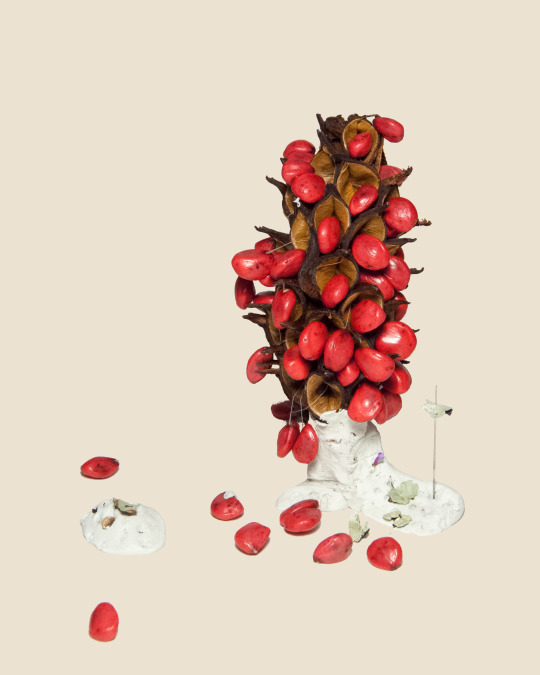
CAConrad is a queer poet who for several years has been working with what he refers to as ‘soma(tic) rituals’, ritualised bodily practices which he completes and then writes from his experiences of. One of these is called Security Cameras and Flowers Dreaming the Elevation Allegiance (For Susie Timmons). CA describes his frustration at the prevalence of security cameras in his home city of Philadelphia (‘FUCK YOU WATCHING US ALWAYS!!’). The ritual resistance he describes involves taking a basket of edible flowers to the scene (‘I eat pansies, I LOVE pansies, they’re delicious buttery purple lettuce!!’). He then looks directly into the camera and proceeds to place his tongue in the flower ‘in and out, flicking, licking, suckling blossoms.’ When confronted by a security guard he responds ‘I’M A POLLINATOR, I’M A POLLINATOR!!’ As soon as it is declared, it becomes obvious that of course he is, undeniably, a pollinator. Despite not being able to facilitate the actual reproduction of the plants, due to species constraints, the small act of resistance towards the security cameras becomes an act of potential pollination, a pollination of politics and ideas and poetry and joy, both a self-pollination and a cross-pollination.[7] The security cameras that CA is resisting are a part of an ecosystem, and he uses his agency as a being within that ecosystem to make a somatic and semiotic intervention against a mode of biopolitical control.
In CA engaging in a sexualised public ritual with flowers, there is also an implied parody of straight anxieties around queer sexuality, such as the argument that legalising gay marriage is a slippery slope towards people being allowed to marry their dogs. Apart from the obvious association of queerness with animality and the non-human, these anxieties are often explicitly or implicitly predicated on the notion that all unreproductive sexual practices are on some level unethical, prioritising pleasure over the continuation of the species. CA’s pollinator intervention gains another dimension when understood in terms of certain species of orchids that have the ability to attract pollinators without a material prize (nectar), but purely on the basis of their imitation of insect sex pheromones, attracting insects on the basis of desire, rather than physical sustenance.
In Animacies, Mel Y. Chen discusses linguistic animacy hierarchies, the way in which language is used to assign different levels of agency to matter, both living and non-living. In English, firmly at the top is the white male subject, everything else placed on a scale somewhere between him and a rock, or other perceived as wholly inactive matter. The argument is that to be compared to anything lower down inherently operates as an insult, in that it implies loss of agency, which is then linked to intelligence, ability, value, and social standing. Chen asks us, ‘If language normally and habitually distinguishes human and inhuman, live and dead, but then in certain circumstances wholly fails to do so, what might this tell us about the porosity of biopolitical logics themselves?’ (Chen, 2012, p7). What are the implications when a being higher up the animacy hierarchy (a human) chooses to align themselves with a ‘lower’ being (for example an insect pollinator)? The act of solidarity both implies a rejection of the value system which places life forms on such a hierarchy, attempting to level the playing field, and recognising how in certain situations it can be desirable to disassociate from the expectations associated with being ‘human’. The situating of ‘homo sapiens’ as something that can be disidentified with and opted out of, rather than a taxonomical fact, finds affinity with Giorgio Agamben’s assertion that ‘Homo sapiens, then, is neither a clearly defined species nor a substance; it is, rather, a machine or device for producing the recognition of the human’ (2003, p26). In addition to active verbal identification with other non-human agents, In The Greenhouse by Veronica Forrest-Thomson highlights how simply the experience of embodied encounter with the non-human can render taxonomies feeling arbitrary and redundant:
The silent rhythm of pulsating pores
filling my lungs with filtered earth
is all I feel or know of alien shapes
that once were flowers.
I breathe their breath
until all definitions are dissolved,
and homo sapiens is nothing more to me.
Perhaps less aligned with Agamben’s definition, these lines find more affinity with Karen Barad’s position that ‘“Humans” are neither pure cause or pure effect but part of the world in its openended becoming’ (2003, 821). Acts of Youth by the late queer poet John Wieners provides another instance of flower-consumption as symbolic of freedom from oppressive power structures.[8] He writes:
The fear of travelling, of the future without hope
or buoy. I must get away from this place and see
that there is no fear without me: that it is within
unless it be some sudden act or calamity
to land me in the hospital, a total wreck, without
memory again; or worse still, behind bars. If
I could just get out of the country. Some place
where one can eat the lotus in peace.
Give me the strength
to bear it, to enter those places where the
great animals are caged. And we can live
at peace by their side.
‘Some place where one can eat the lotus in peace’ is presented as the ultimate sanctuary from the fear and violence of his world, both inner and outer. Flower-eating operates as a literal form of, and metaphor for, spiritual survival precisely because of the low nutritional value of flowers, especially when compared to their high symbolic value. To eat a flower is to aesthetically nourish the body. Eating the lotus in peace is to embody a form of consumption not predicated on a violent conquest, but a gentle taking in of the other into the self, a pleasurable participation in an affective-aesthetic ecology. Wieners desire to live at peace by the side of the great animals in their cages demonstrates an identification with the feral and a siding with the non-human over the human (for who put the animals in cages?). But it is perhaps telling that even in the potentially limitless space of poetics, Wieners chooses to live with caged animals. Trans poet Verity Spott ends her piece Against Trans* Manifestos (2015) with the lines: ‘Determined as it is by a start and a finish, a false double, something that contains at least five harmonic falsities on a liberal map of social reality. Perhaps this is why we have a fetish involving cages; everything impossible to communicate.’ Read against this, Wieners collective desire (‘we’) to live with caged animals becomes a recognition of the contingency of pleasure, and of the description of pleasure as itself a form of caging, and how agency can be enacted whilst being trapped ‘inside’.[9] There is also the issue of temporality within cages, and to what extent temporality is defined by a sense of history and progress, necessarily implying movement and action. Hustak and Myers identify the stationary nature of plants as part of the reason they are placed near the bottom of ‘hierarchies that identify outward motion and action as signs of agency’ (80). This has resonance with the origins of pansy as an insult, as rooted in an notion of thoughtfulness and introspection as effeminate and inferior to active, assertive masculinity. In Our Lady of The Flowers Jean Genet describes the gender identity of the character Divine:
‘Her femininity was not only a masquerade. But as for thinking woman completely, her organs hindered her. To think is to perform an act. In order to act, you have to discard frivolity and set your idea on a solid base. So she was aided by the idea of solidity, which she associated with the idea of virility, and it was in grammar that she found it near at hand. For if, to define a state of mind that she felt, Divine dared use the feminine, she was unable to do so in defining an action which she performed. And all the ‘woman’ judgments she made were, in reality, poetic conclusions.’ (1988, p176)
Solidity and action are associated with the masculine, but this is complicated by the assertion that ‘to think is to perform an act.’ Divine dares to use feminine pronouns for her states of mind, but not in defining her actions. If thinking is an action, then ‘state of mind’ has to be referring to something other than thoughts. The ‘‘woman’ judgements’ she made, which are emphatically not thoughts, are ‘poetic conclusions’. The distinction between active masculine ‘thoughts’ and feminine ‘states of mind’ and ‘poetic conclusions’ is that in order to act, ‘you have to discard frivolity and set your idea on a solid base.’ Solidity and virility are found in grammar, and therefore poetic language is disqualified from the realm of ‘thinking’ due to its frivolity and instability. Its exclusion from thinking as a masculine exercise, outside of solidity and grammar and certainty, means that poetry is in a unique position to express possibilities and potentials outside of dominant thought.
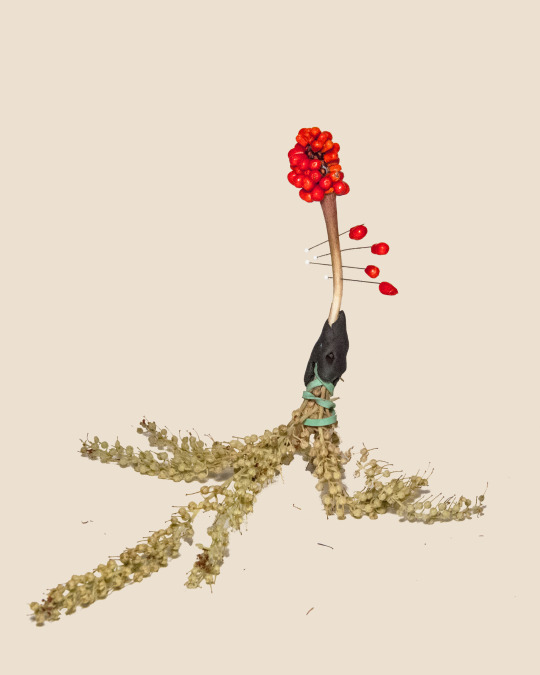
In an essay entitled The Queer Voice: Reparative Poetry Rituals & Glitter Perversions CAConrad describes the somatic rituals he performed to write poetry and attempt to heal himself from the trauma of the homophobic murder of his boyfriend, Earth. One of these rituals results in a dream, where CA finds himself in a garden with Earth, although they do not meet human face to human face. In the garden Earth communicates with CA through flowers who explain to him the difficulty of Earth’s time on earth, acting as prophets from the spirit world whilst remaining entirely grounded in earth and syntax. CA explains that the flowers did not speak with mouths, but ‘their centers mashed up and down as they told me [Earth] could not see me now because he was busy repairing.’ In German the phrase ‘Durch die Blume Gesprochen’, literally ‘spoken through a flower’, means to subtly hint at something without giving away all the details, a minor verbal obfuscation to soften blows or gently allude to an issue. In English, there is ‘flowery language’, with some similar implications and an added air of assumed affectation and pretension (remember the origins of ‘pansy’?). There is also the Latin phrase ‘sub rosa’, literally meaning ‘under the rose’ and used to indicate secrecy and confidentiality. Flowers are seen as untruthful, dishonest in their embodiment, as hiding something under their opulent exteriors. However, in CA’s prophet-flowers the exact opposite is the case, the flowers are messengers of the deepest, most vital truths.
In common parlance there is something in the overtly elaborate and ornate that becomes read as at best wasteful, and at worst deceitful. As a bridge between morphology and semiotics, Georges Bataille colludes with this perspective in The Language of Flowers when he writes, ‘Thus the interior of a rose does not at all correspond to its exterior beauty; if one tears off all of the corolla's petals, all that remains is a rather sordid tuft.’ (Bataille, 1985, p12) The flowers insides are seen as a betrayal of its exterior form, despite that exterior form existing partially for the purpose of attracting insects to the interior. Whilst admitting that some flowers (again, orchids) possess ‘elegant’ stamens, for Bataille this beauty is ‘satanic’, and ‘one is tempted to attribute to them the most troubling human perversions.’ (12) It feels redundant to say that flowers are sexualised, in the sense that they are literally reproductive organs. To be more specific, the sexualisation of flowers is both a cause and consequence of their status as feminine. Bataille makes this misogyny explicit, going on to state that once flowers die, they do not age ‘honestly’ like leaves, but wither like ‘old and overly made-up dowagers.’ (12) Flowers are singled out for their aesthetic qualities, objectified for their external beauty, and reduced to their reproductive function, a feminised position. Simultaneously, they are seen as performing in excess of that role, of being too flamboyant and melodramatic for the task at hand, their beauty seen as a form of deception and trickery. In addition to the obvious analogy with women under patriarchy, this mistrust on the basis of perceived inauthenticity and frivolity also has resonance with a queer position.
To deal first with inauthenticity, I want to suggest that the treatment of artifice as falsification and dishonesty is a feature of straight culture, with little relevance to most queer people. Despite the limitations and dangers of this kind of essentialising, there are material issues at hand. For example, for trans people there is often the sense that an external presentation that could be perceived from the outside to be inauthentic is in fact the most honest expression of their inner selves, and many queer people must keep their desires or certain aspects of their lives internal, or at least restrict who has knowledge of them. To exist as queer in the world requires a certain amount of ‘speaking through flowers’, acknowledging the impossibility and possible undesirability of an entirely transparent existence. Michel Foucault in A History of Sexuality describes the transition from sodomy as a practice into the homosexual as a subject position, ‘a personage, a past, a case history, and a childhood, in addition to being a type of life, a life form, and a morphology, with an indiscreet anatomy and possibly a mysterious physiology […] [sexuality] written immodestly on his face and body because it was a secret that always gave itself away’ (1978, p43). The assumed knowability of the queer body through its naming as such, and that naming giving rise to the presumption of a specific sexual morphology, provides some context for the ambivalent relationship of many queer people to visibility and representation. Speaking through flowers could be a mode of engagement simultaneously flaunting and obscuring one’s ‘indiscreet anatomy’, operating as a form of resistance to and avoidance of biopolitical control, a tactic of conscious illegibility and subterfuge.
A concept closely related to inauthenticity is unnaturalness, both related to the idea that there is a true form that is being betrayed. When Bataille talks of being tempted to attribute to flowers ‘the most troubling human perversions’ it becomes clear that despite falling under the rubric of what is commonly referred to as ‘nature’, the sexuality of flowers is only tenuously perceived as natural. Timothy Morton describes nature as a ‘transcendental term in a material mask’, and the end of a potentially infinite metonymic list: ‘fish, grass, mountain air, chimpanzees, love, soda water, freedom of choice, heterosexuality, free markets…Nature’ (2009, p14). When we accept that there is no actual criteria for naturalness, apart from vague essentialist subjective perception, there is the awkward reality that if something is described as unnatural then it is unnatural, inasmuch as something becomes natural through the same process. As flowers are often read as suspiciously unnatural, they are in some sense are. The unnaturalness of flowers has to do with excess, which is to say wastefulness, which is to say floweriness. To be natural is to fit into a straight human logic of heterosexual reproduction, whether through direct participation or resemblance to the model, to refuse this demand is to be against nature. It is here that both queers and flowers fall through the cracks.
Historically, a large element of what we now refer to as ‘homophobia’ was religiously grounded in the Christian belief that any sexual practices not entirely related procreation were a sin, as they were wasteful of semen. There is an association therefore between queerness and wastefulness, as well as refusal of sexual reproduction, leading to a queer understanding of the necessity of what has been deemed trivial and non-essential, a celebration of earthly pleasures, and a respect for the temporary and fleeting. Nicole Seymour suggests there is something ‘admirable’ and ‘thrillingly ironic’ in queer environmentalism, ‘that those with a foreclosed relationship to “the future” in heteronormative terms would be deeply concerned about the future in ecological terms’ (2012, p63). In In A Queer Time & Place Jack Halberstam makes the argument for queer time as operating within a different logic from straight time, writing that ‘queer subcultures produce alternative temporalities by allowing their participants to believe that their futures can be imagined according to logics that lie outside of those paradigmatic markers of life experience-namely, birth, marriage, reproduction, and death’ (2005, p2). Halberstam ties this specifically to the AIDS crisis, making links with Lee Edelman’s argument for queer anti-futurity (2004). Despite how it is sometimes characterised, this is not a case of ‘positive’ versus ‘negative’ models of queerness, because in theorising anti-futurity as a feature of queerness Edelman betrays a desire for some sense of ‘queer’ as a meaningful, and ultimately positive (by some definition), cohesion. Neel Ahuja argues ‘we might thus benefit from thinking more broadly about reproduction than Edelman does, recognizing that bodies and atmospheres reproduce through complex forms of socio-ecological entanglement.’ Without wanting to reinforce ‘repro-centric’ discourse, I would argue in parallel that what is taking place in queer culture is not a refusal of reproduction, but a cultural, which is to say unnatural, reproduction based on something other than the straight nuclear family unit.[10]
In a soma(tic) ritual entitled Suspension Fluid Magnificence (For Samuel R. Delaney & Stephen Boyer) CA describes approaching men on the street and requesting that they rate their semen on a scale of 1 to 5, with 1 being ‘thin and creamy’ and 5 being ‘cottage cheese.’ He describes this as an attempt to think through ‘how wilderness is memorised in the body’, looking for men to ‘step up to the quiet, feral interior.’ Dealing explicitly with the materiality of biological reproduction, CA does not dismiss the power or significance of semen but rather thinks through how it retains this power and significance as an aesthetic, semiotic, and social material. He writes ‘Semen is fascinating […] The orgasm the flash of light reconnecting to the original proliferation of cells and the construction of sensate flesh, which is a very marvellous thing, being here, all of us.’ In what could have easily been a glorification of straight reproduction CA manages to create an inclusive networked cosmology, a glorification of pleasure and the animistic power of sensate flesh, the wonder of being here, all of us, but no dads. #nodads was a meme originating in 2012 from ultraleft circles on Twitter. Being a meme, its meaning was variable and plural, however the central theme was rejection of the father figure in his oppressive patriarchal role, but equally in more paternalistic caring capacities. In his analysis of the meme Aaron Bady describes it as ‘a rejection of the category [of dad] itself—and of the manner in which it comes to seem a higher order category than many others—it doesn’t necessarily have all that much to do with actual dads, but only by the sociological matrix that makes biology into destiny’ (2012). This feels like a useful model of thinking through biological reproduction, which is to say that none of this is a rejection of the continuation of the human species but rather a thinking through of how reproduction operates when enmeshed with a heterosexual culture which formulates it as the only form of reproduction and life worth celebrating. In this context CA’s cum poetry gestures towards a reconciliation whereby bodily functions can be celebrated as feral and joyous outside of a normative matrix.
To reiterate, this is not to suggest that queer sex is inherently biologically unreproductive, but a reminder that there is a historical context in which queer sex has been framed as wasteful due to its association with unreproductive pleasure. Additionally, there is the factor that biological reproduction is not an organising principal of queer culture, as opposed to straight culture where ‘community is imagined through scenes of intimacy, coupling, and kinship; a historical relation to futurity is restricted to generational narrative and reproduction’ (Berlant and Warner, 1998, p554). If a function of the straight nuclear family is to reproduce the straight nuclear family, queer family cannot rely on this means of reproducing itself, queers cannot take for granted the immortality of reproduction, but this leads to more creative forms of intimacy, kinship, survival and ‘immortality’. Within this framework, it is precisely what is deemed nonessential that is the means of survival: art, poetry, music, fashion, and what Berlant and Warner refer to as ‘parasitic and fugitive elaboration through gossip, dance clubs, softball leagues, and the phone-sex ads’ (p561). In parallel, in flowers it is the colours and scents and delicate forms that are commonly read by human eyes as elaborate and ostentatious that are the bread and butter of survival. Hustak and Myers describe Darwin’s delight in orchids as he saw them as ‘a demonstration that even beautiful forms had utilitarian, adaptive value.’ (75) Although this could be read as an insinuation that forms only have worth if they have utilitarian value, it can also be an understanding that the form and function are inseparable, and the beauty is its own functionality. In a poem referencing the homophobic Black Mountain poet Ed Dorn, CAConrad writes:
i need a soda to
wash this glitter down
it's dark in the stomach
next morning
bathroom light catches
glint of turd covered
in glitter
disco log in the bowl
fecal poetry ranges from
shocking to absurd
this is neither
this is pragmatic
it's my life as i need to live it
Ed Dorn i would kill myself if
i were you but i'm not and
get to live this spectacular
life of sparkling hygiene
CA refuses to frame his glitter consumption as anything other than a practical everyday ritual needed for survival, alongside eating or sleeping, he refuses to draw any distinction between physical, emotional and spiritual survivals. The reality that queer survival is inherently predicated on something other than the physical continuation of the species manifests in a personal sense as survival being about more than the day to day physical maintenance of a body, or more accurately, redefining what constitutes the day to day physical maintenance of a body. This is not to say that it is an abstract and disembodied survival, as what could be more embodied than eating and shitting out glitter? But rather that it treats the body as a vessel for a modest, everyday spiritual joy, no matter how temporary. Pleasure for pleasure and survival’s sake, and always the twain shall meet.
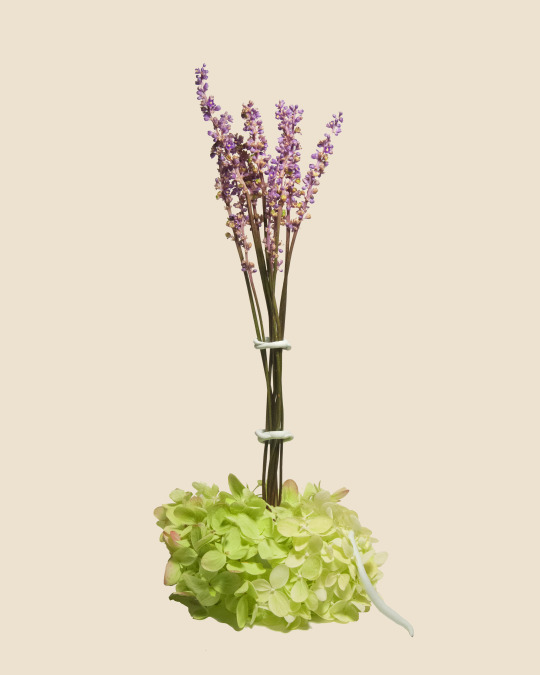
Another poem in the series includes the lines ‘Ed Dorn thinks faggots should drink directly from the sewer / i want to dress special for this.’ There is a provocative knowing that dressing special is not unrelated to why Dorn thinks faggots should drink directly from the sewer, and that dressing special for this punishment will add to his annoyance. In Dorn’s initial comments there is also the implication of queers as wasteful, as undeserving of the privilege of clean tap water; If the ultimate goal is reproduction, queers are a waste of resources. The poem goes on to imagine Dorn asking CA, ‘what camouflage will you wear to hide in the gingerbread house?’ and CA replying ‘none, I want the witch to find me EAT ME!’ This acts as a subversion of survival narratives and demonstrates a lack of belief in the inherent goodness of physical self-preservation and security at all costs. This is not say that physical survival is not important but rather that sometimes it is important for your spiritual survival to allow yourself to be eaten by a witch rather than accept a life of homophobe-endorsed camouflage in the gingerbread house. What are we potentially missing out on when we hide in camouflage in the gingerbread house? Is being eaten by the witch the worst that could happen? In Darwin’s Plots Gillian Beer describes the moment in which the intersection of evolutionary theory and psychological theory became important as it began to ask ‘what emotions and what reflex actions help the individual and race to survive’ (2009, p201). This instrumentalisation of affect seems to shut down the possibility of an ‘affective ecology’ (Hustak and Myers) based on anything other than reproduction.
When asked in interview about his reasons for becoming a writer John Wieners answers, ‘Immortality, in the sense of living after one’s own time has run out’ (1993). Again, there is the sense of ‘life’ as existing beyond an individual’s lifespan, attached to an individual but not necessarily to their physical form or genetics.
Dancing dandelions
and buttercups in the grass
remind me of other summer
flowers, simple blossoms
roses and tiger lilies by the wall
milk pod, sumac branches
lilacs across the road, daisies, blueberries
snaps, cut violets
three years ago still grow in my mind
as peonies or planted geraniums, bachelor buttons
in downy fields filled with clover
lover, come again and again up fern
path upheld as memory’s perennial
against stern hard-faced officers of imprisonment
and cold regulation more painful than lover’s arms
or flowers charming but not more lasting
No, the wild tulip shall outlast the prison wall
no matter what grows within.
In Wiener’s 1969 poem Private Estate, reproduced in its entirety above, a flowing list of flowers ebbs seamlessly into a lover, before the scene is abruptly cut by ‘stern hard-faced officers of imprisonment and cold regulation’. The ambiguous line break after clover leaves the possibility for the ‘clover lover’ as the lover made of clover, or the lover of clover. Years are things that continue to develop and change after their official endings, growing towards the sun, if only in the mind. The cyclical, nonlinear queer time of lover’s arms or flowers is sectioned off by the harsh linear institutional time of the prison or mental hospital. Despite this, these seemingly concrete and immutable structures are presented as ultimately more precarious and fleeting, being outlasted by the wild tulip. In an essay on feminist applications of Darwin, Elizabeth Grosz describes the sense in his work ‘in which the domination of species or individuals is inherently precarious and necessarily historically limited’ (2008, 42). The fragility of power structures and a nondeterministic time is drawn out as a central point where social struggles and biology could find affinity. The tulip is a perennial plant, meaning simply a plant that lives longer than two years, in opposition to biannual and annual plants, which must be replanted more frequently. The taxonomical listing of the poem suggests however that it is not a single tulip that will outlast the prison, but rather wild tulips as a whole, or perhaps even just the idea of the wild tulip. When Wieners speaks of ‘memory’s perennial’ it invites the possibility of the plants having not physically survived at all, yet continuing to grow and thrive in his mind.
This mirrors his statement of desire for immortality through writing. The lines ‘lover, come again and again up fern / path upheld as memory’s perennial’ operate on this ambiguous perennial time, the flirtatious talk of lovers mixing with the seasonal dying back and reblooming of the plants, taking place as a specific memory but also the substance of memory itself. In The Imagination through Time, Wieners speaks of the hour and minute as ‘false divisions of the moon’. The poem ends:
the cautious breath of a friend,
presumably, also up,
in the dark of his house,
who alike hears your thoughts,
wondering; that is a true meeting in eternity.
Not this petty worry
about days, months, proximities
to warmth. There are always fires
on earth, that burn immortally.
For Wieners, human intimacy is a form of immortality, only the ephemeral can come close to touching the eternal. The constant anxiety of looking for comfort and stability (‘proximities to warmth’) is quelled by the knowledge there are always fires burning immortally, somewhere on earth. In another poem about his murdered lover, I Loved Earth Years Ago CA explains, ‘He named himself Earth when planet extinction was clearest.’ The naming decision itself and CA’s recalling of it operate simultaneously as morbid foreshadowing and a hymn to survival and resilience. There is the triple, triangulated meaning of Earth to refer to CA’s lover, the planet Earth, and earth itself, the mud and soil of the world. There is the sense that CA used to love Earth, but there was some rupture that necessitates the use of the past tense, coexisting with the feeling that he has been loving Earth for a long, long time. The statement that he loved Earth years ago does not mean he does not love him now, but there is an acceptance of change. The temporality of the title can be read as an example of Wiener’s ‘perennial time’, neither endless reproduction nor something constricted to a single discrete moment, but something seasonal, ebbing and flowing, perhaps not itself forever, but something, somewhere. In Julia Kristeva’s essay Women’s Time, she suggests that despite being seemingly opposed, eternal and cyclical time, both associated with women, might be closer than they first appear as they both operate outside of linear time (1981). Not wanting to replicate the essentialism of Kristeva’s thought, and in reference to Halberstam (2005), I would argue that this exclusion from (or rejection of) linearity (or straight time) is present not only in women but all who fall outside of the timeframes of normative heterosexuality and gender.[11] In CA’s title there is the evocation of a measurement of time outside of ruling time, a different temporal space: ‘Earth Years’. Earth Years act as a counter to heteronormative timescales, of the years and milestones of straight reproduction, or possibly as a calendar more in tune with the seasons, a rejection of the arbitrary timekeeping divorced from them and enforced as a tool of (re)productivity.
In Permission Please To Be a Stone but You Are A Clock We Say CA writes ‘no wonder clocks aspire to granite’, becoming, ‘don’t allude to my spurt / don’t look at my thighs / you pernicious clocks / make the worst stones’. Jeffrey Jerome Cohen makes the argument that despite being seen as stable and fixed ‘stone is fluid when viewed within its proper duration’ (2015). Clocks can only aspire to the timekeeping abilities of stone, their constant sense of movement and progress overshadowed by the eternal. The honest breaking down of stone into sand usurps the arbitrary time of the constantly flipped hourglass. In Wieners’ words: ‘a true meeting in eternity. / Not this petty worry about days, months, proximities to warmth.’ Tim Dean proposes that ‘queer theorists of spectrality embrace asynchronous temporalities because they regard being haunted as an opportunity to produce a different future, one that the past did not generate but still might’ (2011, p92). This text began with the thoughtful pansy both as a symbol of remembrance and of queer effeminacy, occupying a place of perceived fragility and permanence, its individual lifespan coming up against its collective, symbolic lifespan. Thinking through what I’ve termed queer reproduction, I want to suggest this intersection as politically vital from an ecological perspective for imagining what abundance and joy could mean outside of cycles of physical re/production and consumption. Eternity is not present in static monoliths but in variable, shifting networks of pleasure and affect. In speaking through flowers, which is to say poetry, the consequences of communication are non-linear, cross-pollinated and dispersed, the eternal and cyclical affectively and effectively meeting to produce models of life which could be described as pragmatically opulent. Poetry becomes the language of survival in excess and weaponised floweriness, everything that is ‘too much’ pushing back against false scarcity and repressive taxonomies of gender and sexuality, creating breathing space for a politics of cornucopia, possibility and, propagation outside the already-existing. Fucking pansies speaking through flowers.
‘Do not think of the future; there is none.’
-John Wieners, 6th January 1934 – 1st March 2002

1. From Eric Partridge, A Dictionary of Slang & Unconventional English, 8th edition (1984): pansy, n. A very effeminate youth; a homosexual: from ca. 1925. Cf. Nancy (boy). Also pansy-boy: from ca. 1930; New Statesman and Nation, 15 Sep. 1934, concerning the fascist meeting in Hyde Park on 9 Sep., notes that there were, from the crowd, 'shouts about 'pansy-boys'". ↩
2. The term ‘cisgender’ is used to describe someone who is not transgender, i.e. someone whose gender identity is broadly aligned with the gender they were assigned at birth. ↩
3. See: The Molecularisation of Sexuality by Jordana Rosenburg for a fuller critique of the problems of infinitely abstracting ‘queerness’. ↩
4. Luciana Parisi’s Abstract Sex thinks through these questions of scale and transferability, for example: ‘The biophysical organisation of sex questions the accounts of a human-centred evolution that assimilates sex to sexual reproduction and sexual organs determining the progressive evolution of the body – from bacteria to humans – and sex – from unicellular to multicellular sex’ (p22). ↩
5. See Evolution's Rainbow: Diversity, Gender, and Sexuality in Nature and People by Joan Roughgarden (2009) for wide-ranging accounts of gender and sexual diversity in non-human species. ↩
6. This issue is explored by Eva Hayward with reference to marine life: ‘With the aquarium, the unnerving sexual variation of marine life moved from ocean depths—which was a gothic scene for Victorians—into the inner sanctum of social order and bodily regulation, the aristocratic home. Efforts to know, classify, and conquer the oceanic, and otherwise capture nature for visual pleasure, resulted in a counter conquest of the home by monsters and sexual deviants (2012, p166) ↩
7. This has echoes of Deleuze and Guattari’s writing on the contagion: ‘We oppose epidemic to filiation, contagion to heredity, peopling by contagion to sexual reproduction, sexual production. Bands, human or animal, proliferate by contagion, epidemics, battlefields, and catastrophes. Like hybrids, which are themselves sterile, born of a sexual union that will not reproduce itself, but which begins over again every time, gaining that much ground’ (1987, p241). ↩
8. The flower-eating theme is potentially non-coincidental, as CA has cited Wieners as an influence, and recently edited a collection of his work, Supplication, in which the above poem appears. ↩
9. For more on animal captivity, see Hayward (2012). ↩
10. ‘Repro-centricism’, i.e. the centring of reproduction as the default mode in all discussions of sexual difference, is a term borrowed from Catriona Mortimer-Sandilands and Bruce Erickson in their introduction to Queer Ecologies: Sex, Nature, Politics, Desire (2010), p11. ↩
11. For perspectives on what ‘gay men’s time’ might look like, see: Edelman (2004) and Dean (2011). ↩
Bibliography
Agamben, G., 2003. The Open: Man and Animal. Stanford University Press.
Ahuja, N., 2015. Queer Theory in a Time of Extinctions. GLQ: A Journal of Lesbian and Gay Studies, (21, 2-3), pp. 365-385.
Alaimo, S., 2010. Bodily Natures: Science, Environment, and the Material Self. Indiana University Press.
Bady, A., 2012. America Dads: Louis CK and Barack Obama. The New Inquiry, [online] Available at <http://thenewinquiry.com/blogs/zunguzungu/america-dads-as-ideologylouis-ck-barack-obama-and-nodads-for-fucks-sake/> [Accessed 7 January 2016].
Baedan, 2014. Against the Gendered Nightmare: Fragments On Domestication. Baedan: A Journal of Queer Heresy, 2.
Barad, K., 2003. Posthumanist Performativity: Toward an Understanding of How Matter Comes To Matter. Signs: Journal of Women in Culture and Society, (28, 3), pp. 801-831
Bataille, G., 1985. Visions of Excess: Selected Writings 1927-1939. Minneapolis: University of Minnesota Press.
Beer, G., 2009. Darwin’s Plots: Evolutionary Narrative in Darwin, George Eliot and Nineteenth-Century Fiction. 3rd ed. Cambridge: Cambridge University Press.
Berlant, L. and Warner, M., 1998. Sex in Public. Critical Inquiry, (24, 2), pp. 547-566.
Chen, M. Y., 2012. Animacies: Biopolitics, Racial Mattering, and Queer Affect. Duke University Press.
Cohen, J. J., 2015. Geophilia, or The Love of Stone. Continent., (4, 2), pp. 8-18, [online] Available at <http://continentcontinent.cc/index.php/continent/article/view/181> [Accessed 9 January 2016].
Colebrook, C., 2011. Queer Aesthetics. In: McCallum, E.L. and Tuhkanen, M., eds. Queer Times, Queer Becomings, 2011. pp25-46. Suny Press.
Conrad, C.A., 2014. Ecodeviance: Soma(tics) For The Future Wilderness. Wave Books.
Conrad, C.A., 2015. The Queer Voice: Reparative Poetry Rituals & Glitter Perversions, Poetry Foundation, [online] Available at <http://www.poetryfoundation.org/harriet/ 2015/06/the-queer-voice-reparative-poetry-rituals-glitter-perversions/> [Accessed 6 January 2016].
Dean, T., 2011. Bareback Time. In: McCallum, E.L. and Tuhkanen, M., eds. Queer Times, Queer Becomings, 2011. pp. 75-99
Deleuze, G. and Guattari, F., 1987. A Thousand Plateaus: Capitalism and Schizophrenia. Translated from French by B. Massumi. London: Athlone Press.
Edelman, L. 1994. Homographesis: Essays in Gay Literary and Cultural Theory. New York: Routledge.
Edelman, L., 2004. No Future: Queer Theory and The Death Drive. Duke University Press.
Forrest-Thomson, V., 2008. Collected Poems. Exeter: Shearsman Books.
Foucault, M., 1978. The History of Sexuality, Volume I: An Introduction. New York: Pantheon Books.
Gaard, G., 1997. Toward a Queer Ecofeminism. Hypatia, (12, 1), p137.
Genet, J., 1988. Our Lady of the Flowers. Translated from French by B. Frechtman. Glasgow: Paladin.
Giffney, N. and Hird, J. H., eds., 2008. Queering the Non/Human. Aldershot: Ashgate.
Grosz, E., 2008. Darwin and Feminism: Preliminary Investigations For a Possible Alliance. In: Alaimo, S. and Hekman, S., eds. Material Feminisms, 2008. Bloomington: Indiana University Press. pp23-51.
Halberstam, J., 2005. In A Queer Time & Place: Transgender Bodies, Subcultural Lives. New York University Press.
Hayward, E., 2012. Sensational Jellyfish: Aquarium Affects and the Matter of Immersion. Differences: A Journal of Feminist Cultural Studies, (23, 3) pp. 161-196
Hustak, C., and Myers, N., 2012. Involutionary Momentum: Affective Ecologies and the Sciences of Plant/Insect Encounters. Differences: A Journal of Feminist Cultural Studies, (23,3), pp. 74-118.
Jarman, D., 1992. Modern Nature: The Journals of Derek Jarman. Vintage Classics.
Kristeva, J., 1981. Women’s Time. Translated from French by A. Jardine and H. Blake. Signs: Journal of Women in Culture and Society, (7, 1), pp. 13-35.
Mortimer-Sandilands, C. and Erickson, B., 2010. Introduction: A Genealogy of Queer Ecologies. In: Mortimer-Sandilands, C. and Erickson, B. eds. 2010, Queer Ecologies: Sex, Nature, Politics, Desire. Indiana University Press.
Morton, T., 2009. Ecology without Nature: Rethinking Environmental Aesthetics. Harvard University Press.
Parisi, L., 2004. Abstract Sex: Philosophy, Biotechnology and the Mutations of Desire. Bodmin: Continnuum.
Partridge, E., 1984. A Dictionary of Slang & Unconventional English. 8th ed, Routledge.
Puar, J. K., 2007. Terrorist Assemblages: Homonationalism In Queer Times. Duke University Press.
Radstone, S., 2007. The Sexual Politics of Time: Confession, Nostalgia, Memory. New York: Routledge
Rosenberg, J., 2014. The Molecularization of Sexuality: On Some Primitivisms of the Present. Theory & Event, (17, 2).
Roughgarden, J. 2009. Evolution's Rainbow: Diversity, Gender, and Sexuality in Nature and People. University of California Press.
Seymour, N., 2013. Strange Natures: Futurity, Empathy, and the Queer Ecological Imagination. University of Illinois Press.
Seymour, N., 2012. Toward an Irreverent Ecocriticism. The Journal of Ecocriticism: A New Journal of Nature, Society and Literature, (4, 2). pp. 56-71.
Snediker, M. D., 2009. Queer Optimism: Lyric Personhood and Other Felicitous Persuasions. University of Minnesota Press.
Spott, V., 2015. Against Trans* Manifestos, Two Torn Halves, [online] Available at <http://twotornhalves.blogspot.co.uk/2015/10/against-trans-manifestos.html> [Accessed 8 January 2016].
Wieners, J., 2015. Supplication: The Selected Poems of John Wieners. Wave Books.
Wieners, J., 1993. 'Tenzone' interviews John Wieners. Interviewed by Steve Prygoda. Jacket 2, December 24, 2012, [online] Available at <http://jacket2.org/interviews/tenzoneinterviews- john-wieners> [Accessed 7 January 2016].
6 notes
·
View notes
Text
Green Porno - Isabella Rossellini
Isabella Rossellini’s short films teach us about the diverse sex lives of nonhuman organisms. Many of these animals, using sex for reproduction or social bonding, are undeniably queer. Below are 4 of her queerer videos, but there are plenty more available on youtube. Note how the Shrimp episode shifts from non-human-queer-representation to environmental concerns. The third season of Green Porno focusing on overfishing, presenting the issue alongside the mating habits of sea creatures we consume.
youtube
youtube
youtube
youtube
2 notes
·
View notes
Text
Open Source Gendercodes
Ryan Hammond is an interdisciplinary artist and researcher whose current work, “Open Source Gendercodes,” focuses on the interplay between gender variation and technoscience. By developing novel sex hormone production technologies, OSG attempts to queer current regimes of ownership and biopower.
Ryan and Lee Pivnik discussed OSG, and where the work is at currently for ECOCORE - The Queer Issue.
_______________________________________________________________________

LP: I think it’s important to start with some detailed explanations. I don’t think I’m alone in regrettably feeling ignorant towards the histories of production for most products I consume, and when it comes to hormone production, I never even considered how something like Estrogen makes it from the lab to the individual. Could you explain how hormones are currently being produced, and how your project works to disrupt and democratize that?
RH: In human bodies, all steroid hormones including estrogens (estradiol, estrone, etc.) and androgens (testosterone, dihydrotestosterone, etc.) are produced from cholesterol. Cholesterol is the “substrate” that’s transformed through a series of enzymatically catalyzed chemical reactions to make pregnenolone > progesterone > androstenedione > testosterone > estrone > estradiol. Pharmaceutical steroid hormones are currently produced through multistage fermentation processes, sometimes combined with chemical synthesis steps. Often animal fats, or soybean oil and other plant oils containing phytosterols are used as substrates for microbes that enzymatically transform them. The development of these production technologies from the late 1800’s up to the present is entangled with power structures and ideological frameworks that co-create bodies, subjectivities, and genders. Efforts to eliminate queer, gender non-conforming, non-reproductive behaviors - as well as increase heterosexual prowess and enable lifelong performance of sanctioned masculinities and femininities drove the development of these technologies. Geopolitical forces, state enforced frameworks for the ownership of organisms and biomolecules, colonially imposed and medically enforced binary frameworks of sex and gender, population control and reproductive regimes have sculpted and co-created what we commonly refer to as “male and female sex hormones.” This is what’s most interesting to me, to collage and patch together an image of molecular technologies of gender as hyperobjects that I’m inescapably tangled in, and then involving myself in the parts that are least visible or accessible to me.
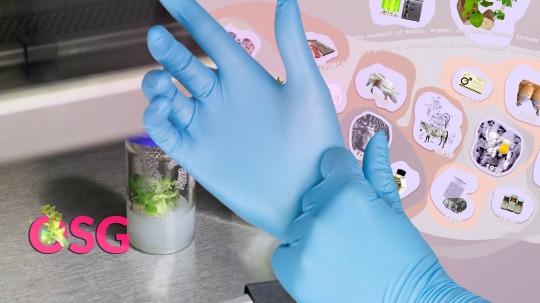
Initially I had hoped to help create a way for people to cheaply produce their own sex hormones and form coops for distributed control and production of drugs. While this is technically feasible with current production technologies and emerging Synthetic Biology techniques (the US military is currently funding several initiatives to produce on demand pharmaceuticals in combat zones in briefcase-refrigerator sized bioproduction units) -- the prospect of an affordable device that could produce hormones in transgenic yeast or plants, and additionally perform extraction, purification, and dosage in a safe way is far in the future.
Using SynBio to develop technologies for, cheap, democratized bioproduction is not an interesting research pathway to pharmaceutical companies because this does not grow profits and consolidate power. If we are going to imagine the “radical potential” of these types of technologies to create alternative futures, we have to find alternative ways to drive research in those directions. This is a special time for synthetic biology as it emerges: regulatory frameworks in the U.S. have yet to constrain the use of gene editing technologies, and the tools of the trade are becoming more accessible and affordable. In the popular imaginings that headline the pop discourse of these technologies, they have the capability to create utopian societies of ecologically synchronous abundance and guilt free consumption, or produce apocalyptic deserts at the whims of basement bioterrorists or unwitting experimenters. Most realistically, these technologies have great potential to calcify and reinforce the current imbalances of power and privilege.
Thinking on a smaller scale, outside of this utopian ideal of democratized bioproduction technologies: development of new, cheaper production methods - and their dedication to the public domain, could enable smaller generics companies to enter the market, drive down prices, and increase availability. This is the logic of the team working on the Open Source Insulin project at Counter Culture Labs as well. Creating “open source” drug production protocols is an act of biotechnical disobedience aimed at interrupting the cycle of patenting and legal monopolies that enable price jacking and profiteering in the health industry.
Additionally, could you briefly explain why tobacco plants work best for this?
I’m not necessarily interested in the tobacco plant itself, but in plants in general. It’s been shown that plant based bioproduction systems have several attractive advantages over yeast, bacterial, or mammalian systems. Namely that they’re less susceptible to contamination, and can dramatically lower the cost of production. This also, in my mind, makes something like an algal bio production system an ideal starting point for small scale, “democratized” bioproduction technologies. I focused on the tobacco plant early on in the project because it is a “model” organism, meaning there is already a large body of research on the plant, it’s genetics, metabolic pathways, etc. It has been metabolically engineered to produce human collagen as well as several vaccines. It also has an unusually high level of cholesterol compared to other plants, and has been previously successfully modified to accumulate cholesterol, and to express the first gene in the human steroid hormone metabolic pathway which effectively increased production of pregnenolone and progesterone.

[IMAGE CREDIT Ma, Julian K-C., Pascal M. W. Drake, and Paul Christou. "Genetic Modification: The Production of Recombinant Pharmaceutical Proteins in Plants." Nat Rev Genet Nature Reviews Genetics 4.10 (2003): 794-805. Web.]
The other reason I’m focusing on a plant system is because a French pharma company has already successfully engineered yeast to produce human steroid hormones (their published research deals with hydrocortisone specifically) and subsequently filed for patent. As far as published research goes - higher plants and algal hosts are uncharted territory for estrogen and androgen production, and aren’t currently subject to ownership claims.
I understand that you’re in a trial stage currently, and you are working on “synthesizing necessary genes and producing transformation plasmids that will be shared with collaborators.” Can you explain this process as well?
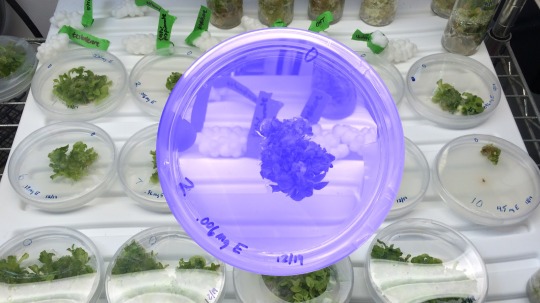
Yes - basically, there are established methods for “designing” genes - creating sequences of nucleotides that are optimized to do what you want them to do in an organism. There is a lot that is not understood still, and a lot of unpredictability -- but there are ways to designate expression levels of genes, ensure proper folding of proteins, signal transport to specific areas within the cell, and support interaction with other molecules through the design of the gene sequences. It’s a lot of reading papers, seeing what worked for other people, messing with sequences of nucleotides, and the eventually sending off your designed sequence to a company that does gene synthesis. Once the gene is synthesized and mailed to you, it can be ligated (covalently bonded onto other DNA fragments with an enzyme called ligase) into a plasmid -- which is just a circular segment of DNA that can be easily transformed into microbes for expression and replication. With the assistance of a plant pathogen called agrobacterium - the synthesized genes can be inserted into plants. In the wild, agrobacterium genetically modify plants - inserting genes that encode production of auxins (plant hormones that induce tumor growth) and other genes that cause the plant to produce nutrients for the bacteria to feed off of. The tumors are called, “crown galls,” once I learned what they look like, I started to notice them everywhere.

You’re taking new precautions during this stage of the project to protect the work from being co-opted and monetized. What led you to this development, and how are you ensuring that you keep the project open to collaboration but guarded from the same companies and corporations that create this accessibility issue in the first place?
There is a trend in the “open source science,” biohacking, and diybio community to open research and dedicate scientific tools to the public domain or “commons” by publishing (after which it is considered “prior art” rendering it unpatentable and open to reuse or modification by anyone). The problem with this is that small modifications can still be patented. For example, let's say that publicly funded research shows that a newly discovered plant contains a potent cancer-therapeutic, which the researchers successfully produced in a bioreactor with transgenic yeast. A pharmaceutical company could then tweak the system outlined in that study to make production more efficient -- then patent the organism or process as an invention and monopolize the market. And this in fact is what happens all the time - research is funded by public tax dollars, and then snatched up by a private company that claims exclusive rights to something which stands on the shoulders of an entire community outside the patent holder.
I also had some discussions with activists and organizers in Baltimore’s queer and trans community and the one message I was hearing from everyone was, “are you really doing enough to protect the work from being co-opted and monetized?” That really resonated with me, so after that I started to work harder to educate myself and search for some way to create this “openness” that is necessary for collaborative science (especially something as complex as metabolic engineering), while still protecting the work from being scooped up and patented by some “business-minded” person.
So with all that in mind I’m working on a web platform to enable secure communication between contractually bound collaborators, as well as to provide a public facing component. Last fall I connected with a biotech lawyer who offered to do some pro-bono work for the project and create a terms of service document for the website which stipulates that if a person uses information or plasmid DNA provided through the website, they must agree to contribute their results and data back to the community under the same terms
After you produce the work that can be shared with collaborators, where can you see this project going? Do you have a desired outcome? --I’m sure outcome is the wrong word, but I’m interested in knowing what effects this research could have.
I am not trained as a scientist -- I am really pushing my mind to do this work because I love the idea and I want to see if flourish. I enjoy the challenge, and the process has been very transformative for me. Scientific research takes a long time, and is inherently uncertain -- especially when dealing with the complexity of biological systems. I’ve had to learn to be open to that uncertainty and to the possibility of finding answers that are not necessarily leading in the direction I started with.
Did you imagine there would be such an overwhelming response to this project when you began it?
I really didn’t -- and I think overwhelming is such a good way to put it. It was actually so beautiful after running the crowdfunder, to hear from many other people who had thought about pursuing the same research and wanted to see it progress. There were also many valid critiques of what the project could become that I had to spend a lot of time with before I felt comfortable proceeding.
Have you found many others working between these communities? Any other exciting people or projects you’d like to highlight?
I’m very excited to see the Open Source Insulin project progress.
There is a group called Gynepunk out of Spain that I think is doing very interesting work on creating DIY/DIWO tools and methods for gynecology.
I’m also a big fan of Paloma Lopez and Leslie Garcia’s work. They have started the Interspecifics Collective in Mexico City, and work on creating open source tools to explore interspecies communication and aesthetics -- generating sound compositions from the movement and electromagnetic activities of microbes and plants as they are affected by human touch and other interactions.
There is also a person named Mary Maggic who is doing what she calls “River Gynecology” by adapting protocols for detecting estrogenic and endocrine disrupting chemicals in waterways with transgenic yeast to a DIY/DIWO context.
I also think that “biohacking” is such a buzz topic right now because it seems very edgy and punk, but there’s a lot of really exciting work happening within the “open source science” movement that isn’t highlighted because it’s not as slick and high-tech heavy as other things. Mboa Nkoudou is doing really interesting work -- expanding on Shiv Visvanathan’s concept of, “Cognitive Justice” to contextualize the open source movement or the “maker movement” to the global south. I met Mboa at the Global Open Science Hardware Conference, where he facilitated discussions on the ways “Open Source” and “Maker Culture” participate in neo-colonialism, and how to change the culture of these communities in the west so that we’re not contributing to neo-colonial efforts intentionally or ignorantly.
Max Liboiron who runs a feminist marine science lab in Canada called Civic Laboratory for Environmental Action Research (CLEAR) is also doing really great work to have critical discussions about equity in the Open Source Science Hardware community.
I was reading about a previous project you did in 2014 titled In Between Utopia and Dystopia, which involved collaborating with a group of high schoolers to speculate how emerging fields in science and tech may shape the future. I’ve been reading José Esteban Muñoz’s Cruising Utopia, The Then and There of Queer Futurity, which challenges us to consider a Queer Utopia.
In his introduction, Muñoz states “Queerness is essentially about the rejection of a here and now and an insistence on potentiality or concrete possibility for another world.” and argues that a queer utopia is necessary to envision as it provides a roadmap towards a better future and an escape from a present where a shortsighted queer politics edges towards assimilation.
Because of your project’s intrinsic futurity and your practice’s history with speculative design, I wanted to know if you’ve considered a Queer Utopia - or would like to, if only for a moment.
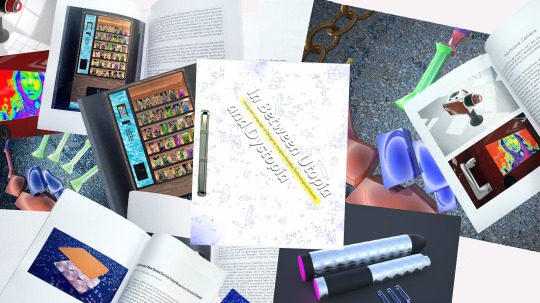
[SPECULATIVE PRODUCT DESIGNS BY Se’daysia Cooper-Lee, Nhiaya Williams, Tayler Corporal, Reona Macklin, Dominique Stepney ]
Yes definitely, this work actually grew out of a speculative fiction practice where I was thinking a lot about what utopic technologies might look like to me. That period of time when I was facilitating speculative fiction workshops was the same time period when I started getting involved at the Baltimore Underground Science Space. In my personal life, I had for a long time been following this scientific discourse on gender and sexual variation that I was exposed to when I was in college in neuroscience classes, and I didn’t really know what to do with it yet.
For me as a non-binary queer person, to learn that there were people putting so much time and money into studying gender and sexual variance was really striking. There’s an immediate anxiety, when you see that people are working so hard to find genetic and neuronal and hormonal differences to define and categorize you (and making money off of it), but there’s also this element of curiosity involved when you see someone offering a neat and tidy deterministic explanation for your own experience. There’s also the underlying fear that the search for a cause, always has the potential to become the search for a cure, or some method of biopolitical regulation of subjectivities.
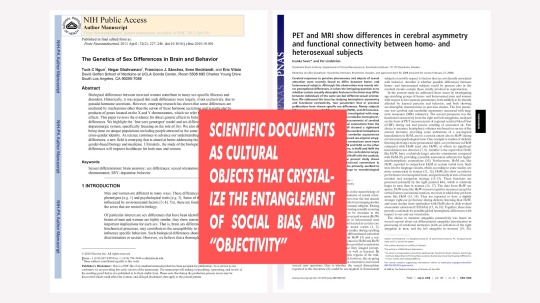
One of the areas that was really fascinating to me was the study of human pheromones. These experiments were very controversial because the way they were structured was filled with bias, and others were not able to reproduce the results consistently. But independent of any discussion of their validity as scientific contributions, they started to become folk knowledge as all these pop articles started circulating their claims: that women were happier and more productive in the presence of male sweat and male pheromones. I started to hear these ideas repeated, I think because it fit so conveniently into our binary socialization of man as a physical laborer and woman as the emotional laborer or the fem customer servant. And it was as if the studies were attempting to naturalize this social contract as reciprocal, innate, and inescapable: Male labor produces sweat, and optimizes the female to do emotional labor. This became my entry point, and I started imagining advertisements for a product that would take advantage and capitalize on this discourse. A desktop bioreactor housing engineered microbes that produce “male” pheremones, marketed to women as a mode of neoliberal empowerment -- or marketed to companies as a way to “optimize” the female worker.
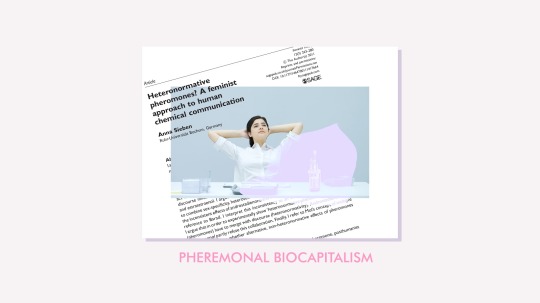
As I dug deeper in the literature, I learned that a lot of pharmaceutical hormones used in birth control and hrt are actually produced by feeding plant oils to microbes during a fermentation process. These pharmaceutical production facilities are like massive prosthetic organs that modulate the enactment of binary gendered subjectivities. This invisible symbiotic relationship between our society and microbes which we’re reliant on for external production of hormones was really interesting, so I started exploring ways to create wearables that might foster a closer or more intentional symbiosis with these microbes.
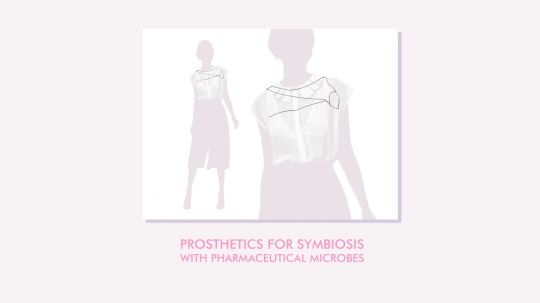
But ultimately I was drawn more to the possibility of using metabolic engineering to develop a bioproduction system for sex hormones, and dedicate it to the public domain. This drew me I think because it has the potential to act on a poetic and performative level, as well as on a more pragmatic level -- becoming a platform to imagine and manifest desires into a queer technology, rather than just a speculative fiction or a “cultural critique.”
3 notes
·
View notes
Text
Working Queer Design Principles, Bodies + Creative Practices, Greta Sk

Amassing narratives of queer design and artistic practices / creating communities / writing manifestos / evolving
Greta Skagerlind has created a pair of Google docs for their ongoing project, Working Queer Design Principles. The first doc is only editable by Greta and the second is made editable to the public, creating community by allowing queer-identified creatives to reflect on how their queerness intersects with their practice.
Read Greta’s principles, Write your own *Click!*
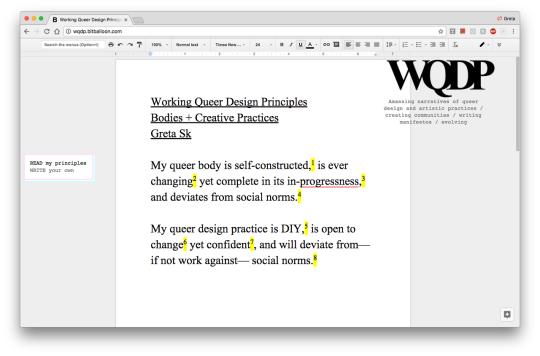



0 notes
Text
Jack Schneider - What is disqualified from existence when we cast humanity in the lead role?

Installation shot of 'Call of Cthulhu' at Born Nude

R'lyeh
Mantis shrimp, acrylic, steel, vinyl tubing, canister filter, heater, live rock, concrete, salt water. 2015
Call of Cthulhu
When I was 12 my friend Matt and I had an extended intermittent debate on the plausibility of the following scenario:
You come across an object that is a color you’ve never seen before. Not just some nuanced color between our familiar red, green and blue. But a radically new color. Like a fourth primary. What happens?
My thought was that you would be so confounded – your once relatively stable image of the universe so fundamentally shaken – that you would die from a cerebral aneurysm or shock.
Matt argued that such a scenario would not be possible in the first place, as we’re only capable of perceiving a select range of colors. Specifically the range of the electromagnetic spectrum between approximately 390 nanometers and 700 nanometers that we call visible light. There are no additional colors, because we do not possess the hardware to perceive them.
Matt’s approach to the scenario corresponds with a correlationist worldview wherein the human experience is tied to reality in such a way that neither could exist without the other. My naive and speculative approach could not stand against this argument, so I conceded.
Revisiting this question now, I have a couple additional challenges. Who was the subject of the scenario? At the time, we assumed it was human. The outcome of the scenario was then necessarily tied to the capacities of human perception. But today, as our bodies become more transparent – as technology probes deeper – new possibilities have become imaginable wherein techno-bio interfaces extend our perceptual capacity.
But even in this supposed solution the existence of something is subordinate to our ability to perceive it. Thus the more important question becomes: what is disqualified from existence when we cast humanity in the lead role?

Installation shot of 'Call of Cthulhu' at Born Nude

Helianthus annuus (320 - 380 nm) Archival print, concrete, resin, Helianthus Annuus, honey bee. 2017
0 notes
Text
The Voluntary Human Extinction Movement
http://vhemt.org/

“May we live long and die out”
Phasing out the human race by voluntarily ceasing to breed will allow Earth’s biosphere to return to good health. Crowded conditions and resource shortages will improve as we become less dense.
Q: What is the Voluntary Human Extinction Movement?
VHEMT (pronounced vehement) is a movement not an organization. It’s a movement advanced by people who care about life on planet Earth. We’re not just a bunch of misanthropes and anti-social, Malthusian misfits, taking morbid delight whenever disaster strikes humans. Nothing could be farther from the truth. Voluntary human extinction is the humanitarian alternative to human disasters.
We don’t carry on about how the human race has shown itself to be a greedy, amoral parasite on the once-healthy face of this planet. That type of negativity offers no solution to the inexorable horrors which human activity is causing.
Rather, The Movement presents an encouraging alternative to the callous exploitation and wholesale destruction of Earth’s ecology.
As VHEMT Volunteers know, the hopeful alternative to the extinction of millions of species of plants and animals is the voluntary extinction of one species: Homo sapiens... us.
Each time another one of us decides to not add another one of us to the burgeoning billions already squatting on this ravaged planet, another ray of hope shines through the gloom.
When every human chooses to stop breeding, Earth’s biosphere will be allowed to return to its former glory, and all remaining creatures will be free to live, die, evolve (if they believe in evolution), and will perhaps pass away, as so many of Nature’s “experiments” have done throughout the eons.
It’s going to take all of us going.
http://vhemt.org/
0 notes
Text
Liby Hays: Trans Termite Queen + Pink Fairy Armadillo
Liby Hays presents two works for The Queer Issue, The Adventures of Ecstatic Gayfinger, THE TRANS TERMITE QUEEN, and PFA Comix. The first of which is a collection of newly written poems from the perspective of a FTM trans termite queen. The second is a webcomic, based on a separate tumblr, linked below.
The Adventures of Ecstatic Gayfinger, THE TRANS TERMITE QUEEN

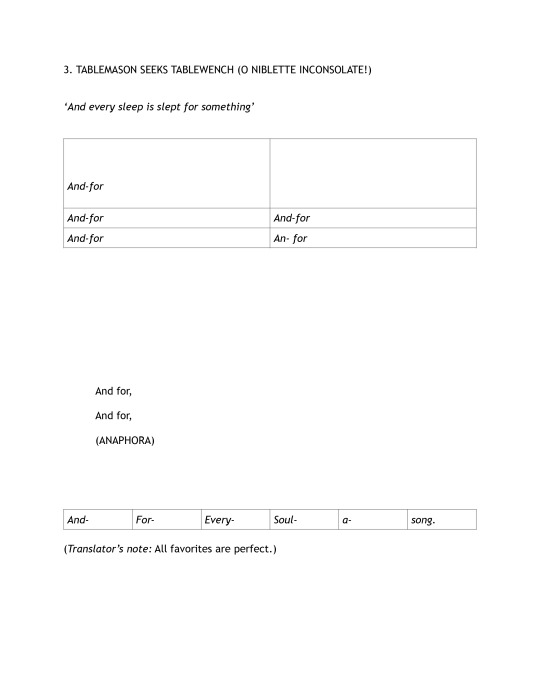


PFA COMIX - Armand, a Pink Fairy Armadillo, comes to terms with his sexuality over the course of middle and high school.
View the webcomic in full at http://pfacomix.tumblr.com/

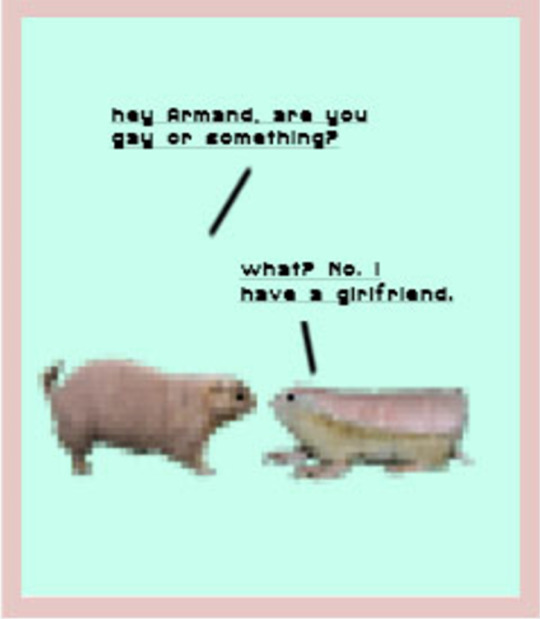
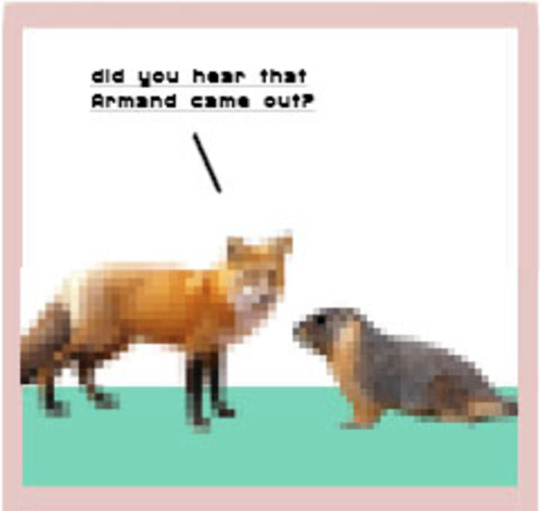

5 notes
·
View notes
Video
vimeo
Alex Ju
Oyster Computer Interaction: Teaching Binary with the MBP Computer
Adornment and ornament are innate tendencies of humanity. This is evidenced by jewelry artifacts dating back to tens of thousands of years ago, as well as by the cavalier attitude with which the ubiquitous object format is taken for granted with today. Similarly historical, some man (Jonathan Swift) once said, “He was a bold man that first ate an oyster.” The first evidence of oyster eating dates back to 164,000 years ago, though whether or not it was a man’s idea cannot be definitively determined.
When oysters became euphemisms for the consumption of women is harder to pinpoint, as is when the perception of jewelry as “feminine” emerged, though there are old oil paintings that affirm the emergence of both. As a jeweler, and, more importantly, the mother of several pet shellfish, this framework can be frustrating. Taking advantage of the potential of new technologies and our strategic Silicon Valley location, my shellfish and I are at the forefront of the new field of Oyster Computer Interaction (OCI). Through our research, we hope to design and develop alternate futures, ones that shine with the luster of a thousand pearls.
-Alex Ju
0 notes
Text
BRUCE BAGEMIHL’S - BIOLOGICAL EXUBERANCE
two excerpts
The Birds and the Bees
The universe is not only queerer than we suppose, it is queerer than we can suppose.[1]
—evolutionary biologist J. B. S. Haldane

In the dimly lit undergrowth of a Central American rain forest, jewel-like male hummingbirds flit through the vegetation, pausing briefly to mate now with a male, now with a female. A whale glides through the dark and icy waters of the Arctic, then surges toward the surface in a playful frenzy of churning water and splashing, her fins and tail caressing another female. Drifting off to sleep, two male monkeys lie gently in each other’s arms, cradled by one of the ancient jungles of Asia. A herd of deer picks its way cautiously through a semidesert scrub of Texas, each animal simultaneously male but not-quite-male, with half-developed, velvety antlers and diminutive, fine-boned proportions. In a protected New Zealand inlet, a pair of female gulls—mated for life—tend their chicks together. Tiny midges swarm above a bleak tundra of northern Europe, a whirlwind of mating activity as males couple with each other in midair. Circling and prancing around her partner, a female antelope courts another female in an ageless, elegant ritual staged on the African savanna.
Although biologist J. B. S. Haldane was not (necessarily) referring to homosexuality when he spoke of the “queerness” of the natural world, little did he know how accurate his statement would turn out to be. The world is, indeed, teeming with homosexual, bisexual, and transgendered creatures of every stripe and feather. From the Southeastern Blueberry Bee of the United States to more than 130 different bird species worldwide, the “birds and the bees,” literally, are queer.[2]
On every continent, animals of the same sex seek each other out and have probably been doing so for millions of years.[3] They court each other, using intricate and beautiful mating dances that are the result of eons of evolution. Males caress and kiss each other, showing tenderness and affection toward one another rather than just hostility and aggression. Females form long-lasting pair-bonds—or maybe just meet briefly for sex, rolling in passionate embraces or mounting one another. Animals of the same sex build nests and homes together, and many homosexual pairs raise young without members of the opposite sex. Other animals regularly have partners of both sexes, and some even live in communal groups where sexual activity is common among all members, male and female. Many creatures are “transgendered,” crossing or combining characteristics of both males and females in their appearance or behavior. Amid this incredible variety of different patterns, one thing is certain: the animal kingdom is most definitely not just heterosexual.
Homosexual behavior occurs in more than 450 different kinds of animals worldwide, and is found in every major geographic region and every major animal group.[4] It should come as no surprise, then, that animal homosexuality is not a single, uniform phenomenon. Whether one is discussing the forms it takes, its frequency, or its relationship to heterosexual activity, same-sex behavior in animals exhibits every conceivable variation. This chapter presents a broad overview of animal homosexuality and places it in the context of a number of other phenomena involving alternative genders and sexualities.

Unnatural Nature
Animals don’t do it, so why should we? Can you even imagine a queer grizzly bear? Or a lesbian owl or salmon? —from a letter written to Dean Hamer, coauthor of The Science of Desire: The Search for the Gay Gene and the Biology of Behavior[5]
Many people, such as the man quoted above, believe that homosexuality does not occur in nature and use this belief to justify their opinions about human homosexuality. In fact, rarely is homosexuality in animals discussed on its own: inevitably, cross-species comparisons are drawn to ascribe moral value to the behavior—both positive and negative. Nowhere is this more apparent than in the notion of “naturalness” and the entire complex of animal-human comparisons that this problematic term evokes. The prevailing view is an overly simplistic one: if homosexuality is believed to occur in animals, it is considered to be “natural” and therefore acceptable in humans; if it is thought not to occur in animals, it is considered “unnatural” and therefore unacceptable in humans. The debate seems clear and the lines of distinction inviolable.
Any careful consideration of the logic behind the equation occurs in animals = natural = acceptable in humans will show, however, that this line of reasoning is flawed. As many people have pointed out, humans engage in a wide variety of behaviors that do not occur in nature, from cooking to writing letters to wearing clothes, and yet we do not condemn these activities as “unnatural” because they are not found among animals. As author Jon Ward explains, with regard to a friend who asserted “You can’t argue with biology” (believing that homosexuality was “unnatural”):
Has he never fried an egg? The whole of human history is an “argument with biology.” The very civilization which the most homophobic ideologues are eager to defend is the antithesis of nature: law and art.[6]
We also use our biology and anatomy in ways that “nature did not intend for them to be used” without ascribing a moral value to such activities. As James Weinrich observes, the tongue’s primary biological purpose is for the act of eating, yet its use in acts of speech, bubble-gum-blowing, or kissing is not therefore considered “unnatural.” In addition, many things that do occur spontaneously in animals—diseases, birth defects, rape, and cannibalism, for example—are not considered to be “natural” or desirable conditions or behaviors in most humans. Weinrich aptly remarks, “When animals do something that we like, we call it natural. When they do something that we don’t like, we call it animalistic.”[7]
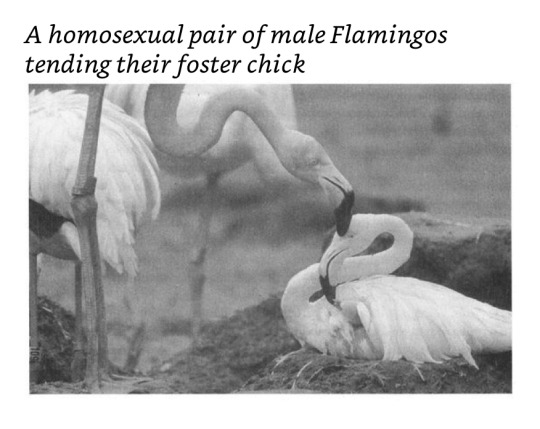
The Natural History of Homosexuality
The historical record also shows that attitudes toward homosexuality have little to do with whether people believe it occurs in animals or not, and consequently, in its “naturalness.” True, throughout much of recorded history, the charge of “unnaturalness” —including the claim that homosexuality did not occur in animals—was used to justify every imaginable form of sanction, control, and repression against homosexuality. But many other interpretations of “naturalness” were also prevalent at various times. Indeed, the very fact that homosexuality was thought to be “unnatural” —that is, not found in nature—was sometimes used to justify its superiority to heterosexuality. In ancient Greece, for example, same-sex love was thought to be purer than opposite-sex love because it did not involve procreation or “animal-like” passions. On the other hand, homosexuality was sometimes condemned precisely because it was considered closer to “nature,” reflecting the base, uncontrolled sexual instincts of the animal world. The Nazis used this reasoning (in part) to target homosexuals and other “subhumans” for the concentration camps (where homosexual men subjected to medical experiments were referred to as “test animals”), while sexual relations between women were disparagingly characterized as “animal love” in late eighteenth-century New England. The irrationality of such beliefs is highlighted in cases where charges of “unnaturalness” were combined, paradoxically, with accusations of animalistic behavior. Some early Latin texts, for instance, simultaneously condemned homosexuals for exhibiting behavior unknown in animals while also denouncing them for imitating particular species (such as the hyena or hare) that were believed to indulge in homosexuality.[8]
In our own time, the fact that a given characteristic of a minority human population is biologically determined has little to do with whether that population should be—or is-discriminated against. Racial minorities, for example, can claim a biological basis for their difference, yet this has done little to eliminate racial prejudice. Religious groups, on the other hand, can claim no such biological prerogative, and yet this does not invalidate the entitlement of such groups to freedom from discrimination. It should be clear, then, that whether homosexuality is biologically determined or not, whether one chooses to be gay or is born that way, or whether homosexuality occurs in nature or not—none of these things guarantees the renders homosexuality “valid” or “illegitimate.”
The debate about the “nature” and origin of homosexuality often invokes seemingly opposite categories: genetics versus environment, biology versus culture, nature versus nurture, essentialism versus constructionism. Indeed, the very categories “homosexual” and “heterosexual” are themselves examples of such a dichotomy. By using these categories, biologists and social scientists hope to discover what aspects of homosexuality, if any, are biologically determined. Yet by framing the debate in terms of such categories, it is easy to forget that more complex interactions between factors must be considered. For example, most research shows that both environment and biology are relevant in determining sexual orientation in people (and probably also animals). Some individuals may have an innate predisposition for homosexuality, but the right combination of environmental (including social) factors is required for this to be realized. And how meaningful is it to talk about a culture-nature distinction when, as we have just seen, some animal species have themselves developed forms of cultural behavior? Similarly, by focusing attention on the “causes” of homosexuality, the determinants of heterosexuality are considered irrelevant—or, alternatively, heterosexuality is assumed to be inevitable unless something “goes wrong.” And not all sexuality fits neatly into the categories of exclusive homosexuality or exclusive heterosexuality—the large realm of experience that involves bisexuality is easily glossed over in discussions about the origins of homosexuality/heterosexuality. So, too, with the question of whether homosexuality is “natural” and what its occurrence in animals can tell us about this: things are considerably more complicated than they initially appear.
What is remarkable about the entire debate about the naturalness of homosexuality is the frequent absence of any reference to concrete facts or accurate, comprehensive information about animal homosexuality. Those who argue against the naturalness of homosexuality assert with impunity that same-sex behavior does not occur in nature (like the man quoted above) and is therefore self-evidently abnormal. Those who argue in favor of a biological origin for homosexuality often ignore the complexities of animal behavior arising from social, protocultural, or individual life-history factors (relying on the behavior of laboratory animals injected with hormones, for example, instead of long-term studies of animals interacting in their own social groups or communities).[9] This is because naturalness is more a matter of interpretation than facts. Now that the widespread occurrence of animal homosexuality is beginning to be documented, little if anything is likely to change in this discussion. More information about same-sex activity in animals simply means more possible interpretations: the information can be used to support or refute a variety of positions on the naturalness or acceptability of homosexuality, depending (as before) on the particular outlook of whoever is drawing the conclusions.
As James Weinrich points out, the only claim about naturalness that is actually consistent with the facts is the following: homosexual behavior is as natural as heterosexual behavior.[10] What this means is that homosexuality is found in virtually all animal groups, in virtually all geographic areas and time periods, and in a wide variety of forms—as are heterosexuality, divorce, monogamy, and infanticide, among other things. Conversely, heterosexuality is as “unnatural” as homosexuality is, since it often exhibits social elaboration or cultural “embellishment,” as well as many of the “unacceptable” features stereotypically associated with same-sex relations, such as promiscuity, nonreproduction, pursuit of sexual pleasure, and interactions marked by instability, ineptitude, and even hostility.[11] But whether this means that homosexuality is “biologically determined” and/or “socially conditioned” —and by extension, (un)acceptable in humans—is largely a question of interpretation. Of course, from a scientific perspective, the sheer extent and variety of homosexual expression in the animal world reveals an aspect of nonhuman biology and social organization that is unexpected—one with far-reaching (perhaps even revolutionary) implications. It demands careful consideration and suggests a rethinking of some of our most fundamental notions of environment, culture, genetics, and evolutionary and social development. But to automatically conclude that because homosexuality occurs in animals, it must be biologically determined oversimplifies the debate and does an injustice to the facts.
For most people, animals are symbolic: their significance lies not in what they are, but in what we think they are. We ascribe meanings and values to their existence and behaviors in ways that usually have little to do with their biological and social realities, treating them as emblems of nature’s purity or bestiality in order to justify, ultimately, our views of other human beings. The animals themselves remain enigmatic, mute in the face of this seemingly endless onslaught of human interpretations of their lives. If this were merely a matter of debate among people, it could perhaps be put in its proper perspective as simply yet another human folly. Unfortunately, the interpretations applied to animal (sexual) behaviors by people are far from innocuous: they can have grave consequences, or even be a matter of life or death—for both humans and animals alike. When a gay man or lesbian is assaulted or murdered because the attacker thinks that homosexuality is “unnatural,” for example, or when politicians’ legislative and judicial decisions concerning homosexuality are coded in such terms as “crimes against nature,” much more is at stake than the scientific interpretation of animal behavior.[12]
The moral value ascribed to animal sexuality can also impact directly on the welfare of the creatures themselves. In 1995 a biologist with the U.S. Fish and Wildlife Service briefed Senator Jesse Helms’s staff about the value of saving an endangered bird, the red-cockaded woodpecker, which lives in the southeastern United States.[13] His presentation stressed the supposed “family values” of the species, referring to the birds’ monogamous and relatively long-lasting heterosexual pair-bonds. In other words, the right of this species to exist—as determined by legislators voting on the Endangered Species Act—was predicated not on its intrinsic value, but on how closely its behavior could be made to resemble what is currently considered acceptable conduct for humans. And this is most definitely a case of presenting an idealized “image” of the species: the red-cockaded woodpecker’s “family values” are in reality far more complex, messy, and “questionable” than what the politicians were told.
True, this species usually breeds in long-term, monogamous pairs, but its social life is replete with variations on this theme, some of which Senator Helms would have found downright horrifying.[14] Many family groups in this species are unstable: one six-year investigation found that only six out of thirteen breeding pairs remained together, while studies of the species in Helms’s home state of North Carolina revealed that nearly 20 percent of females in this population desert their mates and switch family groups. Males sometimes leave their partners as well, and the overall (species-wide) divorce rate is about 5 percent; nonmonogamous copulations also occasionally occur, with slightly more than 1 percent of nestlings being fathered by a male other than their mother’s mate. Red-cockaded woodpeckers also frequently live in “stepfamilies” or “blended families”: more than a quarter of the younger birds who live in breeding groups and help with parenting duties may be related to only one parent, and 5–11 percent are related to neither. Some of these “helper” birds engage in decidedly un-family-like activities, such as ousting a parent from its group or even committing “stepfamily incest” by mating with the remaining parent. Incest involving full or half siblings, though rare, also occurs. Other helpers forgo reproduction entirely (continuing to live with their parents as adults for several years), and there are also solitary nonbreeding birds in the population, as well as all-male groups. Some red-cockaded woodpecker groups may also be polygamous or “plural” breeding units, with two females both breeding (or trying to breed) at the same time.
Would the red-cockaded woodpecker be considered less “deserving” of protection if Senator Helms and his staff learned that these birds participate in nonreproductive sexual activity (mating during incubation, or long before egg-laying), or siblicide and starving of offspring, or infanticide and chick-tossing from the nest? All of these behaviors have been documented in this species, yet none were included in the scientific presentation to the politicians in whose hands this bird’s fate rests, for they would shatter the illusion of its “family values.” Homosexual activity has not (yet) been observed in red-cockaded woodpeckers, although it does occur in related species such as Acorn Woodpeckers and Black-rumped Flamebacks. Should such behavior come to light, one can only dread the consequences for this, or any other, endangered species whose survival depends on human assessment of its “moral conduct.”
Homosexuality has a “natural history” in every sense of the term: that is, it has both biological (“natural”) and social or cultural (“historical”) dimensions that are interconnected and inseparable. It is not a uniform phenomenon in either animals or people: it takes many forms, and it exhibits numerous variations and idiosyncrasies. The interplay of biology and environment in shaping these features—and indeed, the very definitions of what is “cultural” as opposed to “biological”—is far more complex than polarized debates would have us believe. Because the discussion is often framed in terms of misleading dichotomies such as “nature versus nurture” or “genetics versus environment,” the possibility that both are relevant (and can influence one another) is repeatedly overlooked, as is the possibility that sexual behavior in some animals has a significant sociocultural component. Yes, homosexuality occurs in nature and apparently always has. But does this make it “natural” or simply “animalistic”? The answer to this question is entirely in the eye of the beholder, rather than in any inherent quality or context of the phenomenon itself.
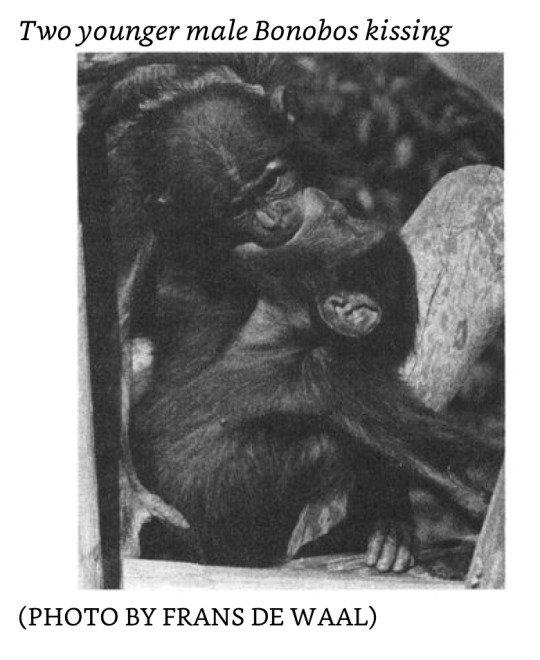
Haldane, J.B.S. (1928) Possible Worlds and Other Papers, p.298 (New York: Harper & Brothers). ↩
Animal names that are capitalized refer to a species or group of closely related species that is profiled in part 2, or whose references are included in the appendix. ↩
Homosexuality among primates, for example, has been traced back to at least the Oligocene epoch, 24-37 million years ago (based on its distribution among contemporary primates; Vasey 1995:195).Some scientists place its original appearance even earlier in the evolutionary line leading to mammals, at around 200 million years ago (Baker and Bellis 1995:5), and it has probably existed for much longer among other animal groups. Vaseu, P.L. (1995) “Homosexual Behavior in Primates: A Review of Evidence and Theory,” International Journal of Primatology 16:173-204; Baker, R., and M.A. Bellis (1995) Human Sperm Competition: Copulation, Masturbation, and Infidelity (London: Chapman and Hall). ↩
See note 29, as well as part 2 and the appendix, for more detailed tabulations (including discussion of species not included in this tally). ↩
Hamer, D., and P. Copeland (1994) The Science of Desire: The Search for the Gay Gene and the Biology of Behavior, p. 213 (New York: Simon and Schuster). ↩
Ward, J. (1987) “The Nature of Heterosexuality,” in G. E. Hanscombe and M. Humphries, eds., Heterosexuality, pp. 145-69. (London: GMP Publishers). ↩
Weinrich, J. D. (1982) “Is Homosexuality Biologically Natural?” in W. Paul, J. D. Weinrich, J. C. Gonsiorek, and M. E. Hotvedt, eds., Homosexuality: Social, Psychological, and Biological Issues, pp. 197-208 (Beverly Hills, Calif: SAGE Publications). For an early discussion of animal homosexuality in relation to the question of “naturalness,” see Gide, A. (1911/ 1950) Corydon (New York: Farrar, Straus, and Co.). ↩
Weinrich, ibid.; Plant, R. (1986) The Pink Triangle: The Nazi War Against Homosexuals, pp. 27, 185 (New York: Henry Holt); Grau, G., ed., (1995) Hidden Holocaust? Gay and Lesbian Persecution in Germany 1933— 45, p. 284 (London: Cassell); Mann, M. (1797/ 1866) The Female Review: Life of Deborah Sampson, the Female Soldier in the War of the Revolution, p. 225 (Boston: J. K. Wiggin & W. P. Lunt) [excerpts reprinted in Katz, J. (1976) Gay American History, pp. 212— 214 (New York: Thomas Y. Crowell)]. Boswell, J. (1980) Christianity, Social Tolerance, and Homosexuality: Gay People in Western Europe from the Beginning of the Christian Era to the Fourteenth Century, p. 309 (Chicago: University of Chicago Press). ↩
For a summary and overview of such experimental studies (e.g., involving hormones), see Mondimore, F. M. (1996) A Natural History of Homosexuaity, pp. 111— 13, 129-30 (Baltimore: Johns Hopkins University Press). These studies, typically involving laboratory rats, also invariably overlook the fact that the homosexual behaviors “induced” by hormones and other experimental treatments occur spontaneously in the wild ancestors of the laboratory animals involved, e.g., (European) Brown Rats (cf. Barnett 1958). Concerning further pitfalls in extrapolating from laboratory animals, as well as a general discussion of the “nature versus nurture” controversy, see Byne, W. (1994) “The Biological Evidence Challenged,” Scientific American 270( 5): 50— 55; LeVay, S., and D. H. Hamer (1994) “Evidence for a Biological Influence in Male Homosexuality,” Scientific American 270( 5): 44— 49. ↩
Weinrich, “Is Homosexuality Biologically Natural?” p. 207. ↩
See chapter 5, as well as the animal profiles in part 2, for specific examples. ↩
For explicit statements by gay-bashers to the effect that homosexuality is “not natural,” see Comstock, G. D. (1991) Violence Against Lesbians and Gay Men, p. 74 (New York: Columbia University Press). ↩
Middleton, S., and D. Liittschwager (1996) “Parting Shots?” Sierra 81( 1): 40— 45. ↩
For documentation of these activities, see the following sources: Ligon, J. D. (1970) “Behavior and Breeding Biology of the Red-cockaded Woodpecker,” Auk 87: 255-78; Lennartz, M. R., R.G. Hooper, and R. F. Harlow (1987) “Sociality and Cooperative Breeding of Red-cockaded Woodpeckers, Picoides borealis,” Behavioral Ecology and Sociobiology 20: 77-88; Walters, J. R., P. D. Doerr, and J. H. Carter III (1988) “The Cooperative Breeding System of the Red-cockaded Woodpecker,” Ethology 78: 275-305; Walters, J. R. (1990) “Red-cockaded Woodpeckers: A ‘Primitive’ Cooperative Breeder,” in P. B. Stacey and W. D. Koenig, eds., Cooperative Breeding in Birds: Long-Term Studies of Ecology and Behavior, pp. 69-101 (Cambridge: Cambridge University Press); Haig, S. M., J. R. Walters, and J. H. Plissner (1994) “Genetic Evidence for Monogamy in the Cooperatively Breeding Red-cockaded Woodpecker,” Behavioral Ecology and Sociobiology 34: 295-303; Rossell, C. R., Jr., and J. J. Britcher (1994) “Evidence of Plural Breeding by Red-cockaded Woodpeckers,” Wilson Bulletin 106: 557-59. ↩
1 note
·
View note
Text
ECOCORE The Queer Issue

cover 1: Exene Karros @donaldtrompeloeil

cover 2: Andrej Dubravsky @andrej_dubravsky

cover 3: Caspar Jade Heinemann @angstravaganza
ECOCORE is proud to announce issue 6, an online only issue dedicated to queer strategies in nature. Following the US withdrawal from the Paris Climate Agreement it is urgent to find new approaches to ecology and environmentalism.
Starting today @ blog.ecocore.co
Queerness is not yet here. Queerness is an ideality. Put another way, we are not yet queer. We may never touch queerness, but we can feel it as the warm illumination of a horizon imbued with potentiality. We have never been queer, yet queerness exists for us as an ideality that can be distilled from the past and used to imagine a future.
-José Esteban Muñoz,
Cruising Utopia: The Then and There of Queer Futurity
Ecocore’s sixth issue, The Queer Issue, guest edited by The Institute of Queer Ecology (IQECO), operates at the intersection of queer and environmental discourse, with a mission to improve both fields. Each movement, perpetually evolving though not fast enough, benefits from being in conversation with the other.
Yesterday I found myself at one of the last shows of the Ringling Bros. and Barnum & Bailey Circus, in Providence, Rhode Island. I had just left a meeting with two other members of IQECO, where we discussed the types of invisible labor being done by plankton (plus other microbial Foundation Species) and queer (human) communities. When I arrived at the circus, then, I found myself still burdened with criticality.
When the lights went out and spotlights hit a cage in the center of the arena, 12 tigers were sitting on stools and I braced myself for an unnerving show. A large man with dueling whips lashed the tigers, ordering the cats to jump, roar, stand, and move about. I sank lower into my chair, feeling rather microbial as a crowd of thousands clapped and screamed in excitement at the spectacle of human supremacy.
Earlier, as the National Anthem had boomed, a lesbian couple sat down next to me and I let out a sigh of relief. The three of us would form an instant unspoken alliance for the next 3 hours, silently critiquing the The Greatest Show on Earth. So when the 12 tigers began leaping in fear of a man who commanded them and the audience into a frenzy, I looked towards my newfound queer sisters. I was disappointed to see that they too were cheering, hand in hand.
I lay out this anecdote to highlight the dangerous rift still standing between queer and environmental justice. I expected the couple next to me to naturally align themselves with the subjugated tigers, rather than with oppressive man. But as critical conversations about ecology and queerness are still far from the mainstream, this way of thinking takes time and dedication. Eventually, I believe it will prove incredibly helpful for both the lgbt+ community and the natural world. This new alignment allows queer individuals to find kin with any oppressed species, many of which are queerer than we imagined. While tigers have not yet been observed to engage in homosexual behavior, at least another 1,500 species have, including lions, where homosexual and trans individuals have been recorded.
Our simplified collective understanding of human gender and sexuality collapses on itself when we are confronted by a fungus with 28,000 sexes. Catriona Sandilands states (while discussing the works of Elizabeth Wilson and Myra Hird) that “nonhuman sexual and gender diversity both calls into question human exceptionalism and destabilizes notions of identity, authenticity, and technology on which modern categories of human sexual orientation rest.” The research is overwhelming and powerful, as exemplified by the enduring influence of Bruce Bagemihl’s seminal text, Biological Exuberance. Bagemihl’s book about animals with homosexual tendencies was used as evidence by the American Psychiatric Association before the US Supreme Court in Lawrence v. Texas, a case that ultimately struck down sodomy laws in 14 states.
The Queer Issue presents IQECO’s inaugural attempt to present a sliver of this growing body of research, as well as works by artists that consider this hybridized way of thinking. The Queer Issue is assembled eclectically, with republished texts by Bruce Bagemihl that have heavily influenced the field, as well as original commissions for the occasion of this issue. Liby Hays will present a collection of four poems from the perspective of a Trans Termite Queen. Briohny Walker will contribute a new paper on an ethics of failure and futurelessness. Greta Skagerlind invites you to contribute to their ever-growing in-flux definition of Queer Design Principles via a collaborative google doc. Ryan Hammond will talk about their ongoing work, Open Source Gender Codes, which attempts to queer current regimes of pharmaceutical production and systems of ownership by producing open source hormone production protocols.
Ecocore and IQECO welcome you to The Queer Issue.
Edited by Lee Pivnik for the Institute of Queer Ecology
Bruce Bagemihl
Urban Barnyard
Alessandro Bava
Andrej Dubravsky
Ryan Hammond
Liby Hays
Caspar Heinemann
Alex Ju
Exene Karros
Les U. Knight / VHEMT
Lee Pivnik
Isabella Rossellini
Jack Schneider
Greta Skagerlind
Briohny Walker
Additionally, we would like to out our non-human contributors. The following is a list of animals that have been recorded exhibiting either homosexual or transgender behavior, assembled by Bagemihl in his 1999 publishing of Biological Exuberance. Their vibrant and diverse existence reminds us with force that we are not alone in our queerness, but should our species continue to encroach on their habitats, we may find ourselves increasingly lonesome.
Acorn Woodpecker
Addax
Antelope
Adelie Penguin
African Buffalo
African Elephant
African jacana
African swallowtail butterfly
Agile Wallaby
akepa
Allen hummingbird
Amazon Molly
Amazon River Dolphin see Boto
American Bison
American kestrel
angelfish
Anna’s Hummingbird
ant
Aoudad
Aperea
arctic tern
Asiatic Elephant
Asiatic Mouflon
Atlantic Spotted Dolphin
Australian noisy miner
Australian raven
Australian Sea Lion
Australian Shelduck
avocet
Aztec Parakeet
badger
Bank Swallow
Barasingha
Barbary Sheep
Barn Owl
barn swallow
bat
bearded seal
beaver
Beluga Bengalese Finch (Domestic)
bewick’s swan
Bezoar
Bharal
Bicolored Antbird
Bighorn Sheep
bird of paradise
black-and-white warbler
Black Bear
Black-billed Magpie
Blackbuck
black-capped chickadee
black-capped lorikeet
Black-crowned Night Heron
Black-footed Rock Wallaby
black-headed grosbeak
Black-headed Gull
Black-rumped Flameback
Black Stilt
Black Swan
Black-tailed Deer
black-tailed gull
black-tailed prairie dog
Black-winged Stilt
Blue-backed Manakin
Blue-bellied Roller
blue-billed duck
bluebird
bluejay
Blue Sheep see Bharal
bluethroat
Blue Tit
Blue-winged Teal
boat-tailed grackle
Bonnet Macaque
Bonobo
Boto
Bottlenose Dolphin
bowerbird
Bowhead Whale
Bridled Dolphin
Brown Bear see Grizzly Bear
brown booby
Brown Capuchin
Brown-headed Cowbird
Brown Long-eared Bat
brown noddy
Brown Rat Budgerigar (Domestic)
Buff-breasted Sandpiper
bufflehead duck
burro
Bush Dog
butterfly
Calfbird
California Gull
California sea lion
Canada Goose canary
Canary-winged Parakeet
Caribou
Caspian Tern
cassowary
Cat (Domestic)
Cattle (Domestic)
Cattle Egret
centipede
Chaffinch
Cheetah
Chicken (Domestic)
Chiloe Wigeon
chimney swift
Chinese water deer
clapper rail
Cliff Swallow
Collared Peccary
Commerson’s Dolphin
Common Brushtail Possum
Common Chimpanzee
Common Dolphin
Common Garter Snake
Common Gull
Common Marmoset
Common Murre
Common Pipistrelle
Common Raccoon
Common Shelduck
Common Tree Shrew
coral goby
cormorant
Costa’s hummingbird
cottontail rabbit
Cotton-top Tamarin
coyote
coypu
Crab-eating Macaque
crane
crane fly
Crane spp.
Crested Black Macaque
crow
Cui
curlew
cutworm
Dall’s Sheep see Thinhorn Sheep
Damaraland mole-rat
Daubenton’s Bat
Dayak fruit bat
Desert Tortoise
dipper
Dog (Domestic)
Doria’s Tree Kangaroo
dragonfly
Dragonfly spp.
Dugong
Dusky Moorhen
Dwarf Cavy
Dwarf Mongoose
eagle earthworm
Eastern Bluebird
Eastern Cottontail Rabbit
Eastern Gray Kangaroo
echidna
Egyptian Goose
eider duck
Eleanora’s falcon
Elegant Parrot Elk see Wapiti
emperor penguin
Emu
Euro
European Bison see Wisent
European jay
European Shag
falcon
Fallow Deer
False Killer Whale
Fat-tailed Dunnart finch
Fin Whale
firefly
fisher
Flamingo
fox
fox squirrel
frog, poisonous
fruit bat
Fruit Fly spp.
fulmar
Galah
garter snake
gecko
Gelada Baboon
Gentoo Penguin
giant cowbird
giant river otter
Giraffe
glaucous-winged gull
Goat (Domestic)
Golden Bishop Bird
golden eagle
golden lion tamarin
Golden Monkey
Golden Plover
Gorilla
Grant’s Gazelle
Gray-breasted Jay
Gray-capped Social Weaver
gray-cheeked mangabey
Gray-headed Flying Fox
Gray Heron
Gray Seal
Gray Squirrel
Gray Whale
great bustard
Great Cormorant
great crested flycatcher
great egret
Greater Bird of Paradise
greater painted-snipe
Greater Rhea
great tit
Green Sandpiper
Greenshank
Greylag
Goose
Griffon Vulture
Grizzly Bear
grouper
grouse
Guianan Cock-of-the-Rock
Guillemot see Common Murre Guinea Pig (Domestic)
Hamadryas Baboon
hamlet Hammerhead
Hamster (Domestic)
Hanuman Langur
Harbor Porpoise
Harbor Seal
hare
Harris’s hawk
Harris’s sparrow
hawk
hawkmoth
hedgehog
heron
Herring Gull
Himalayan Tahr
Hoary-headed Grebe
Hoary Marmot
honeybee
hooded pitohui
Hooded Warbler Horse (Domestic)
house martin
House Sparrow
Humboldt Penguin
humbug damselfish
humpback whale
hyena
Indian Fruit Bat
Indian Muntjac
Indian Rhinoceros
Ivory Gull
jabiru stork
jacana
Jackdaw
jackrabbit
Japanese Macaque
Japanese sea raven
Javan wart snake
Javelina see Collared Peccary
jellyfish
kalanga parrot
Kangaroo Rat
kentish plover
Kestrel
Killer Whale
king bird of paradise
King Penguin
kit (blue) fox
Kittiwake
kiwi
Koala
Kob
lantern bass
lantern fish
Lapland longspur
lapwing
Larga Seal see Spotted Seal
Laughing Gull
Laysan Albatross
Least Chipmunk
Lechwe lemming
lesser black-backed gull
Lesser Bushbaby
Lesser Flamingo
lesser kestrel
Lesser Scaup Duck
lesser yellowlegs
Lion
Lion-tailed Macaque
Lion Tamarin
Little Blue Heron
Little Brown Bat
Little Egret
Livingstone’s Fruit Bat
Long-eared Hedgehog
Long-footed Tree Shrew
Long-legged Fly spp.
long-tailed duck
Long-tailed Hermit Hummingbird
long-tailed manakin
loon
lorikeet
lucifer hummingbird
lunulated antbird
magnificent hummingbird
Mallard Duck
marabou stork
marbled murrelet
Markhor
marmoset
marsupial mouse
Marten sp.
Masked Lovebird
Matschie’s Tree Kangaroo
Mazarine Blue
Mealy Amazon Parrot
Mew Gull see Common Gull
Mexican Jay see Gray— breasted Jay
mink
Mocó
Mohol Galago see Lesser Bushbaby
mole
mole-rat
mole-vole
Monarch Butterfly
monitor lizard
Montagu’s harrier
Moor Macaque
Moose
moth
Mountain Goat
mountain lion
Mountain Tree Shrew
Mountain Zebra
Mule Deer
murre
Mustached Tamarin
mustached warbler
Musk Duck
Musk-ox
Mute Swan
naked mole-rat
natal robin
Natterer’s Bat
New Zealand fur seal
New Zealand Sea Lion
nightjar
Nilgiri Langur
Noctule
North American Porcupine
Northern Elephant Seal
Northern Fur Seal
northern jacana
northern lapwing
Northern Quoll
northern rough-winged swallow
Ocellated Antbird
Ocher-bellied Flycatcher
Olympic Marmot
one-wattled cassowary
opossum
Orange Bishop Bird
Orange-fronted Parakeet
Orang-utan
Orca see Killer Whale
oriole
Ornate Lorikeet
osprey
Ostrich
owl
oyster
1 note
·
View note
Video
vimeo
The Institute of Queer Ecology
The Institute of Queer Ecology is a collaborative organism dedicated to bringing queer discourse to ecology.
Our mission is to use biology and evolution to contextualize non-normative sexualities, adaptations, and presentations. Our programming is interdisciplinary and revolves around migratory exhibitions, online publications, and a yearly journal.
We are always looking to collaborate with scientists, artists, queers, theorists, writers, designers, people, plants, and animals. Interested in working with us? We’d love to hear from you! - [email protected]
1 note
·
View note
Text
SI SEDES NON IS
Curated by Milovan Farronato
07/04 - 26/08/17
The Breeder
45 Iasonos st.
10436, Athens


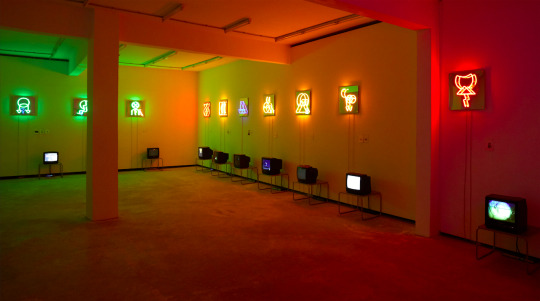

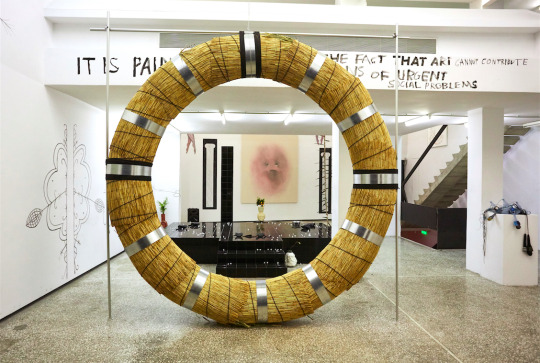
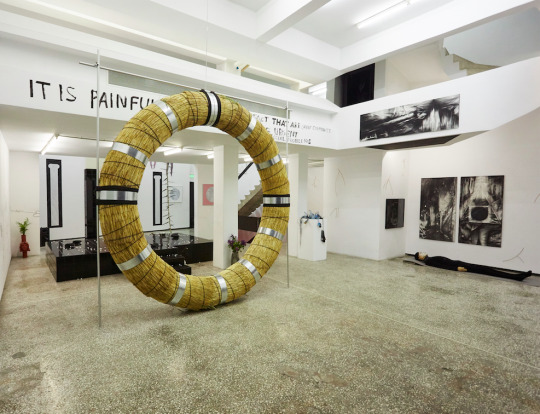
Enrico David, Joana Escoval, Anna Franceschini, Delia Gonzalez, Camille Henrot, Karl Holmqvist, Christian Holstad, Maria Loboda, Goshka Macuga, Lucy McKenzie, Paulina Olowska, Christodoulos Panayiotou, Angelos Papadimitriou, Micki Pellerano, Angelo Plessas, Gareth Pugh, Mathilde Rosier, Prem Sahib, Vanessa Safavi, Socratis Socratous
a missive coming from some place in space and time After the Event (A.E.)
Ciao Milovan, I hope you are doing well, sailing on your ship, the Little Flowers, far, far away from here. I've been wanting to write to you for a long while now, after the coup d'état - a theatrical play orchestrated from you - has taken place. You'll be curious to know how things went, I guess. Well, here you go, let's begin from the start.
We are in A., it's the end of March. The work has almost come to a conclusion, everything is irreversibly ready by now. Old banknotes, whips corrugated out of uses and reuses, they are swishing in the springtime wind of the Mediterranean, still carrying a humid trace within it before the big summer aridity. The stocks diagrams are shining like silver paths, nerves of a lithe, mutable financial body. The stage is empty, the auditorium silent. It's full of writings everywhere. I cannot understand them all, some of them seem to have been written in unknown languages, thousands of years old. Some other just seem to be scribbles. Verbal junk. One catches my attention, maybe as it's the only one in capital letters: WHAT TIME IS LOVE?
In a corner, a bunch of withered mikes waits to be picked up by hands with aerograph- polished nails and refreshed by a voice of dew. There are roses, there are crosses. The dancers and the singers are holed up downstairs, enlightened by pale video reflections, the flickering of digital flames, iridescent and cold on their vaguely smiling faces. Some are pacing back and forth, highly strung, on top of some really high crystal heels which only by miracle are not hitting against the shaped neon tubes on the ground, sinuous snakes of light leading the path. The New Ideologies are almost ready to be sung. The Texts of Invocations will be superimposed during the TV live coverage, on April 6th, so that all of the world can come together in a big global and ecumenical karaoke. The airing date has been widely discussed, then the dolphins rhetorically took over and the Illuminati acknowledged the date would have been the Sixth of April. And now, Milovan, here we are; it's time, irreversibly the time.
Forgive me now, just on the thick of it I need to make my farewells!
They are calling me, they are about to open the hermetic door.
tanti baci, Anna
#Enrico David#Joana Escoval#Anna Franceschini#Delia Gonzalez#Camille Henrot#Karl Holmqvist#Christian Holstad#Maria Loboda#Goshka Macuga#Lucy McKenzie#Paulina Olowska#Christodoulos Panayiotou#Angelos Papadimitriou#Micki Pellerano#Angelo Plessas#Gareth Pugh#Mathilde Rosier#Prem Sahib#Vanessa Safavi#Socratis Socratous#Milovan Farronato
0 notes
Text
Mirrors
01.04 - 21.04.17 Monday-Friday 10-18 or by appointment.
2nd Floor. Via Visconti di Modrone 18, 20122, Milano
John Armleder, Enrico Baj, Marco Casentini, CCH, Maria Adele Del Vecchio, Claire Fontaine, Lucio Fontana, Gaia Fugazza, Alberto Garutti, Thomas Grunfeld, Alicja Kwade, Franco Mazzucchelli, Marco Pio Mucci, Claudio Parmiggiani, Michelangelo Pistoletto, James Rosenquist, SAGG Napoli, Martin Soto Climent, Massimo Uberti, Renato Volpini, Andrea Williamson
The exhibition, which opens on 31st March in conjunction with MiArt Fair week, comes from an idea by Alessandro Buganza and his collaboration with Margherita Castiglioni.
As the title suggests, the theme explores mirrors as a medium, and how such reflective surfaces have influenced artists and artistic researches from the 1960s until today. The show focuses on well established artists from the 20th Century as well as on international emerging artists. The juxtaposition of their works aims to create a dialogue between the works, highlighting how the use of mirrors has been adopted by artists for more than half a century.
With a range of artworks that spans from the 1960s to 2017, the show intends to stimulate an in-depth analysis on the history of art, in which the same motif transforms according to not only to the artist’s personality but also to the technological development the world has seen throughout history.
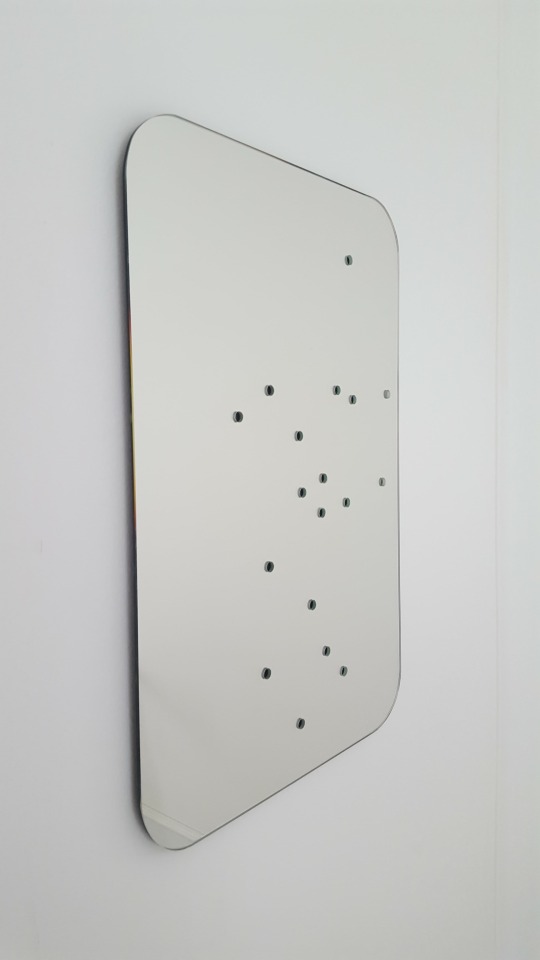


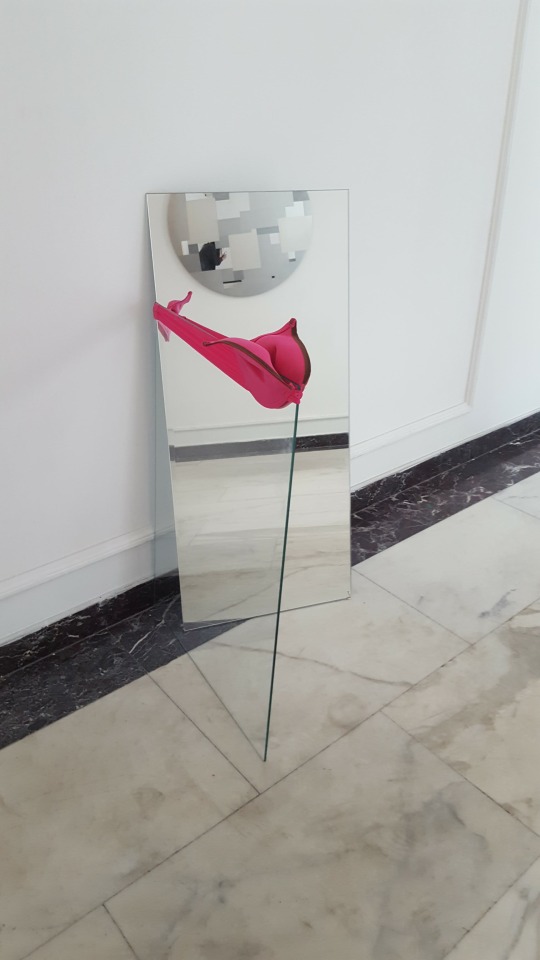
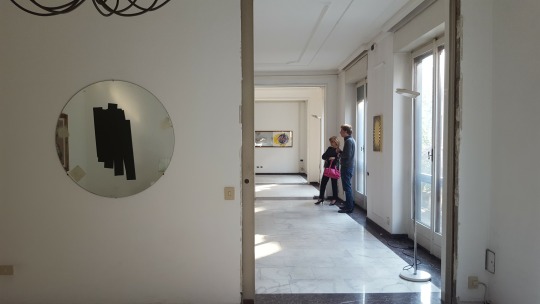



1 note
·
View note
Text
The Gate FW17 Lookbook
ECOCORE presented The Gate Collective Fall Winter 2017 fashion line at Stanley Picker Gallery on March 20th 2017.
The Gate fashion show launched the latest collection of clothing produced by members of The Gate.
On the same day photographer Benjamin Whitley shot the accompanying lookbook.
The Gate Arts Project is a collective of artists working from an arts centre for adults with learning disabilities in Shepherd’s Bush, West London. Over the years they have produced a number of gigs, plays, books of poetry as well as contributing to academic texts. Their activities span from weekly comedy series on Youtube to music and exhibitions. They have worked with the ICA and V&A, and host a weekly radio show on Resonance FM titled The Gate Kicks.
Video of the runway show by The Gate here

Model Eileen wears the consumption top and bracelet designed by herself and Carol.
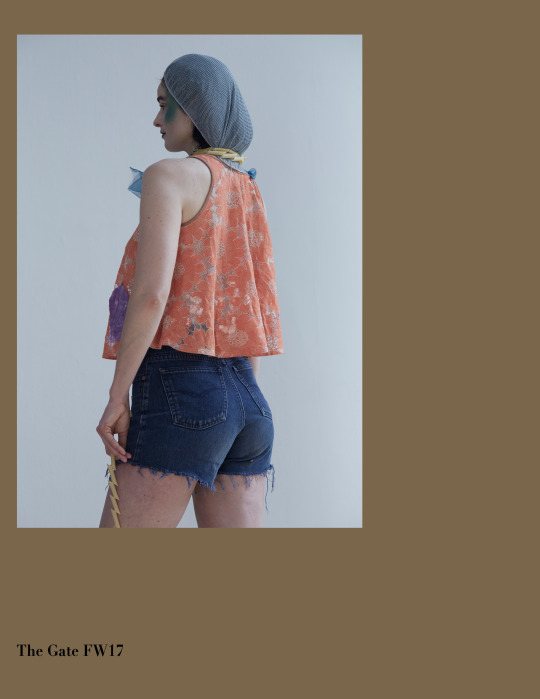
Model Marlie wears net top designed by Anon and collaged denim shorts designed by Michael.
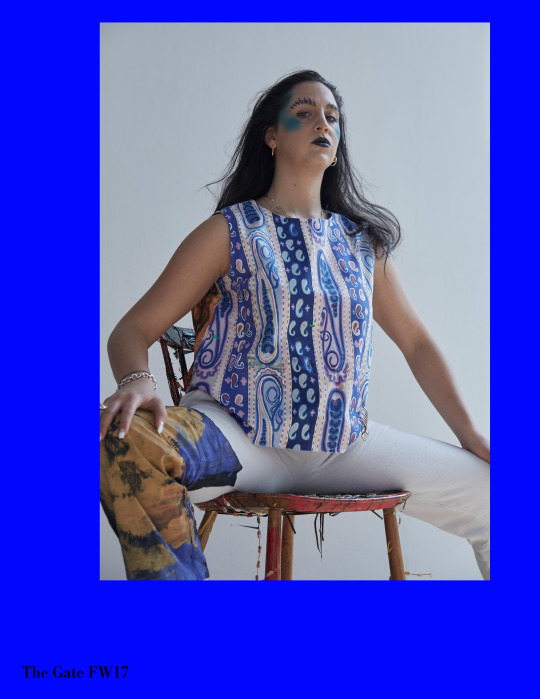
Model Sofia wears top designed by Jimmy and denim leg piece designed by Michael.

Model Jonathan wears Staff shirt and black trousers designed by Michael and carries Sims bag designed by Labake.

Model Jessica wears tie-dye shirt and leather two-piece designed by Jason.

Model wears patchwork trousers designed by Salim

Model Mariann wears shirt designed by Duane and black trousers designed by Leon and pencil shoes designed by Mary.

Model Lotte wears denim vest designed by Mandy and Marissa and pasta necklace designed by Labke.

Model Patricia wears wedding cap, shirt, and wrap skirt designed by herself.

Model Valerio wears pasta hat designed by Carol, t-shirt designed by Mary, and denim shorts designed by Michael.
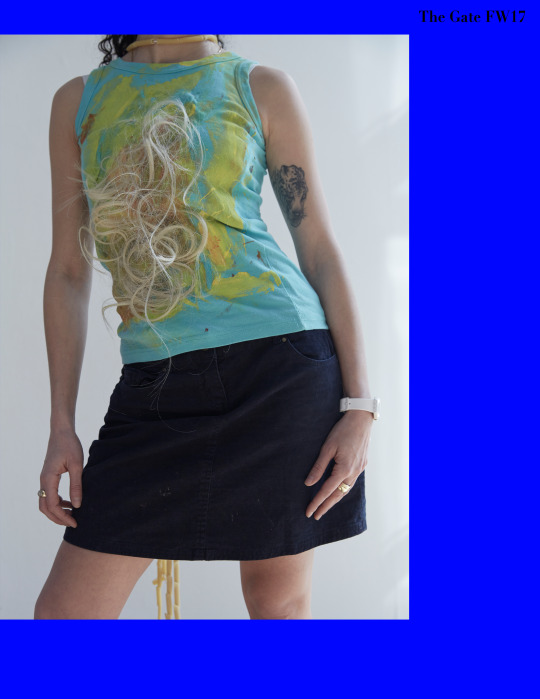
Model Stella wears aqua top designed by Jimmy.

Model Jessica wears sleeveless shirt designed by Jazz and multi-layered skirt with barcode designed by Labake and Luke.
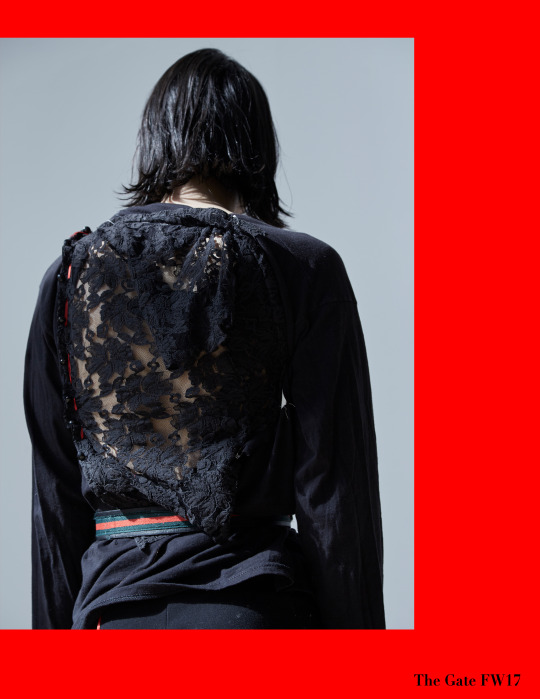
Model Jonathan wears Frieze Staff shirt and black trousers designed by Michael and carries Sims bag designed by Labake.

Model Valerio wears pasta hat designed by Carol, t-shirt designed by Mary, and denim shorts designed by Michael.

Model Alessandro wears pencil t-shirt designed by Duane.
Thank you to everyone who made this possible: Lena Tutunjian, Stella Bottai. Hannah Gilbert. Roxy Shi. Namuun J, Dani, Ellie, Benjamin Whitley, Owen Pratt. Prurple PR, Milovan Farronato, Marlie Mul, Jonathan Small, Sofia Gianni, Lily Pattern, Louis Backhouse, Lotte Andersen, Valerio Bava, Jessica Pappalardo, Mariann Metsis, mandy cummings, claire miller, mary o'shaughnessy, kashan, carol pley, jackie, salim, leon, jason, labake manners,duane, marissa, eddy, eileen, patricia, jimmy, wayne, michael, jazz, eloise, musa, hern, and the entire community from the Gate.
Photographer: Benjamin Whitley
Creative Direction: Bava and Sons
Make-Up: Matilde Ceruti Quara
Set Design: The Gate
Music: Owen Pratt
#fashion#fashion show#lookbook#styling#clothing vetements#vetements#clothing#collage#garments#ecocore#the gate#54thegate#makeup#runway#fw17#fw2017
0 notes